Attached files
| file | filename |
|---|---|
| 8-K - FORM 8-K - CNO Financial Group, Inc. | form8k.htm |

Unless
otherwise specified, the periods cited in our
performance comparisons are Q1 2010 vs Q1 2009.
performance comparisons are Q1 2010 vs Q1 2009.
Exhibit
99.1
First
Quarter 2010
Financial
and Operating Results
For
the period ended March 31, 2010
Conseco,
Inc.
May
5, 2010

2
Forward-Looking
Statements
Cautionary
Statement Regarding Forward-Looking Statements. Our statements,
trend analyses and other information contained in these
materials relative to markets for Conseco’s products and trends in Conseco’s operations or financial results, as well as other statements,
contain forward-looking statements within the meaning of the federal securities laws and the Private Securities Litigation Reform Act of 1995.
Forward-looking statements typically are identified by the use of terms such as “anticipate,” “believe,” “plan,” “estimate,” “expect,” “project,”
“intend,” “may,” “will,” “would,” “contemplate,” “possible,” “attempt,” “seek,” “should,” “could,” “goal,” “target,” “on track,” “comfortable with,”
“optimistic” and similar words, although some forward-looking statements are expressed differently. You should consider statements that
contain these words carefully because they describe our expectations, plans, strategies and goals and our beliefs concerning future business
conditions, our results of operations, financial position, and our business outlook or they state other ‘‘forward-looking’’ information based on
currently available information. Assumptions and other important factors that could cause our actual results to differ materially from those
anticipated in our forward-looking statements include, among other things: (i) our ability to continue to satisfy the financial ratio and balance
requirements and other covenants of our debt agreements; (ii) general economic, market and political conditions, including the performance and
fluctuations of the financial markets which may affect our ability to raise capital or refinance existing indebtedness and the cost of doing so; (iii)
our ability to generate sufficient liquidity to meet our debt service obligations and other cash needs; (iv) our ability to obtain adequate and timely
rate increases on our supplemental health products, including our long-term care business; (v) the receipt of any required regulatory approvals
for dividend and surplus debenture interest payments from our insurance subsidiaries; (vi) mortality, morbidity, the increased cost and usage of
health care services, persistency, the adequacy of our previous reserve estimates and other factors which may affect the profitability of our
insurance products; (vii) changes in our assumptions related to the cost of policies produced or the value of policies in force at the effective
date; (viii) the recoverability of our deferred tax assets and the effect of potential ownership changes and tax rate changes on its value; (ix) our
assumption that the positions we take on our tax return filings, including our position that our 7.0% convertible senior debentures due 2016 will
not be treated as stock for purposes of Section 382 of the Internal Revenue Code of 1986, as amended, and will not trigger an ownership
change, will not be successfully challenged by the Internal Revenue Service; (x) changes in accounting principles and the interpretation thereof;
(xi) our ability to achieve anticipated expense reductions and levels of operational efficiencies including improvements in claims adjudication
and continued automation and rationalization of operating systems, (xii) performance and valuation of our investments, including the impact of
realized losses (including other-than-temporary impairment charges); (xiii) our ability to identify products and markets in which we can compete
effectively against competitors with greater market share, higher ratings, greater financial resources and stronger brand recognition; (xiv) the
ultimate outcome of lawsuits filed against us and other legal and regulatory proceedings to which we are subject; (xv) our ability to complete the
remediation of the material weakness in internal controls over our actuarial reporting process and to maintain effective controls over financial
reporting; (xvi) our ability to continue to recruit and retain productive agents and distribution partners and customer response to new products,
distribution channels and marketing initiatives; (xvii) our ability to achieve eventual upgrades of the financial strength ratings of Conseco and our
insurance company subsidiaries as well as the impact of rating downgrades on our business and our ability to access capital; (xviii) the risk
factors or uncertainties listed from time to time in our filings with the Securities and Exchange Commission; (xix) regulatory changes or actions,
including those relating to regulation of the financial affairs of our insurance companies, such as the payment of dividends and surplus
debenture interest to us, regulation of financial services affecting (among other things) bank sales and underwriting of insurance products,
regulation of the sale, underwriting and pricing of products, and health care regulation affecting health insurance products; and (xx) changes in
the Federal income tax laws and regulations which may affect or eliminate the relative tax advantages of some of our products. Other factors
and assumptions not identified above are also relevant to the forward-looking statements, and if they prove incorrect, could also cause actual
results to differ materially from those projected. All written or oral forward-looking statements attributable to us are expressly qualified in their
entirety by the foregoing cautionary statement. Our forward-looking statements speak only as of the date made. We assume no obligation to
update or to publicly announce the results of any revisions to any of the forward-looking statements to reflect actual results, future events or
developments, changes in assumptions or changes in other factors affecting the forward-looking statements.
materials relative to markets for Conseco’s products and trends in Conseco’s operations or financial results, as well as other statements,
contain forward-looking statements within the meaning of the federal securities laws and the Private Securities Litigation Reform Act of 1995.
Forward-looking statements typically are identified by the use of terms such as “anticipate,” “believe,” “plan,” “estimate,” “expect,” “project,”
“intend,” “may,” “will,” “would,” “contemplate,” “possible,” “attempt,” “seek,” “should,” “could,” “goal,” “target,” “on track,” “comfortable with,”
“optimistic” and similar words, although some forward-looking statements are expressed differently. You should consider statements that
contain these words carefully because they describe our expectations, plans, strategies and goals and our beliefs concerning future business
conditions, our results of operations, financial position, and our business outlook or they state other ‘‘forward-looking’’ information based on
currently available information. Assumptions and other important factors that could cause our actual results to differ materially from those
anticipated in our forward-looking statements include, among other things: (i) our ability to continue to satisfy the financial ratio and balance
requirements and other covenants of our debt agreements; (ii) general economic, market and political conditions, including the performance and
fluctuations of the financial markets which may affect our ability to raise capital or refinance existing indebtedness and the cost of doing so; (iii)
our ability to generate sufficient liquidity to meet our debt service obligations and other cash needs; (iv) our ability to obtain adequate and timely
rate increases on our supplemental health products, including our long-term care business; (v) the receipt of any required regulatory approvals
for dividend and surplus debenture interest payments from our insurance subsidiaries; (vi) mortality, morbidity, the increased cost and usage of
health care services, persistency, the adequacy of our previous reserve estimates and other factors which may affect the profitability of our
insurance products; (vii) changes in our assumptions related to the cost of policies produced or the value of policies in force at the effective
date; (viii) the recoverability of our deferred tax assets and the effect of potential ownership changes and tax rate changes on its value; (ix) our
assumption that the positions we take on our tax return filings, including our position that our 7.0% convertible senior debentures due 2016 will
not be treated as stock for purposes of Section 382 of the Internal Revenue Code of 1986, as amended, and will not trigger an ownership
change, will not be successfully challenged by the Internal Revenue Service; (x) changes in accounting principles and the interpretation thereof;
(xi) our ability to achieve anticipated expense reductions and levels of operational efficiencies including improvements in claims adjudication
and continued automation and rationalization of operating systems, (xii) performance and valuation of our investments, including the impact of
realized losses (including other-than-temporary impairment charges); (xiii) our ability to identify products and markets in which we can compete
effectively against competitors with greater market share, higher ratings, greater financial resources and stronger brand recognition; (xiv) the
ultimate outcome of lawsuits filed against us and other legal and regulatory proceedings to which we are subject; (xv) our ability to complete the
remediation of the material weakness in internal controls over our actuarial reporting process and to maintain effective controls over financial
reporting; (xvi) our ability to continue to recruit and retain productive agents and distribution partners and customer response to new products,
distribution channels and marketing initiatives; (xvii) our ability to achieve eventual upgrades of the financial strength ratings of Conseco and our
insurance company subsidiaries as well as the impact of rating downgrades on our business and our ability to access capital; (xviii) the risk
factors or uncertainties listed from time to time in our filings with the Securities and Exchange Commission; (xix) regulatory changes or actions,
including those relating to regulation of the financial affairs of our insurance companies, such as the payment of dividends and surplus
debenture interest to us, regulation of financial services affecting (among other things) bank sales and underwriting of insurance products,
regulation of the sale, underwriting and pricing of products, and health care regulation affecting health insurance products; and (xx) changes in
the Federal income tax laws and regulations which may affect or eliminate the relative tax advantages of some of our products. Other factors
and assumptions not identified above are also relevant to the forward-looking statements, and if they prove incorrect, could also cause actual
results to differ materially from those projected. All written or oral forward-looking statements attributable to us are expressly qualified in their
entirety by the foregoing cautionary statement. Our forward-looking statements speak only as of the date made. We assume no obligation to
update or to publicly announce the results of any revisions to any of the forward-looking statements to reflect actual results, future events or
developments, changes in assumptions or changes in other factors affecting the forward-looking statements.

Non-GAAP
Measures
3
This
presentation contains the following financial measures that differ from the
comparable measures
under Generally Accepted Accounting Principles (GAAP): operating earnings measures; book value,
excluding accumulated other comprehensive income (loss) per share; operating return measures;
earnings before net realized investment gains (losses) and corporate interest and taxes; debt to capital
ratios, excluding accumulated other comprehensive income (loss); and interest-adjusted benefit ratios.
Reconciliations between those non-GAAP measures and the comparable GAAP measures are
included in the Appendix, or on the page such measure is presented.
under Generally Accepted Accounting Principles (GAAP): operating earnings measures; book value,
excluding accumulated other comprehensive income (loss) per share; operating return measures;
earnings before net realized investment gains (losses) and corporate interest and taxes; debt to capital
ratios, excluding accumulated other comprehensive income (loss); and interest-adjusted benefit ratios.
Reconciliations between those non-GAAP measures and the comparable GAAP measures are
included in the Appendix, or on the page such measure is presented.
While
management believes these measures are useful to enhance understanding and
comparability
of our financial results, these non-GAAP measures should not be considered substitutes for the most
directly comparable GAAP measures.
of our financial results, these non-GAAP measures should not be considered substitutes for the most
directly comparable GAAP measures.
Additional
information concerning non-GAAP measures is included in our periodic filings
with the
Securities and Exchange Commission that are available in the “Investor - SEC Filings” section of
Conseco’s website, www.conseco.com.
Securities and Exchange Commission that are available in the “Investor - SEC Filings” section of
Conseco’s website, www.conseco.com.

Q1
2010 Summary
4
CNO
§ Core
sales* of $87 million, up 4%
§ Net
operating income** $38.2 million, up 2%
• 14 cents per diluted
share
• Reflects dilution
from the issuance of shares of common stock and
convertible debentures
convertible debentures
§ Consolidated
RBC up 10 points to 319%
§ Holding
company liquidity: $131.2 million
§ Book
value per share: $15.24 vs $15.14 at 12/31/09
*Excludes PFFS and
PDP.
**Management
believes that an analysis of net income applicable to common stock before: (1)
loss on
extinguishment or modification of debt, net of income taxes; and (2) net realized investment gains or losses,
net of related amortization and income taxes (“Net operating income,” a non-GAAP financial measure) is
important to evaluate the financial performance of the company, and is a key measure commonly used in the
life insurance industry. Management uses this measure to evaluate performance because loss on
extinguishment of debt and realized investment gains or losses can be affected by events that are unrelated to
the company’s underlying fundamentals. The table on page 8 reconciles the non-GAAP measure to the
corresponding GAAP measure.
extinguishment or modification of debt, net of income taxes; and (2) net realized investment gains or losses,
net of related amortization and income taxes (“Net operating income,” a non-GAAP financial measure) is
important to evaluate the financial performance of the company, and is a key measure commonly used in the
life insurance industry. Management uses this measure to evaluate performance because loss on
extinguishment of debt and realized investment gains or losses can be affected by events that are unrelated to
the company’s underlying fundamentals. The table on page 8 reconciles the non-GAAP measure to the
corresponding GAAP measure.

CIG
Segmentation
5
CIG
§ Splitting
into two segments:
• Other CNO
Business
• Washington
National
§ Other
CNO Business comprised primarily of closed blocks from CIG
• Will be separately
managed from current/growing business
• Accounts for about
two-thirds of CIG’s capital
§ Segmentation
is another step toward increased transparency of operations
• Will bring clearer
accountability and focus on business strategies
§ Expect
to begin reporting on new segment basis effective Q3 2010
• Bankers
• Colonial
Penn
• Washington
National
• Other CNO
Business
• Corporate
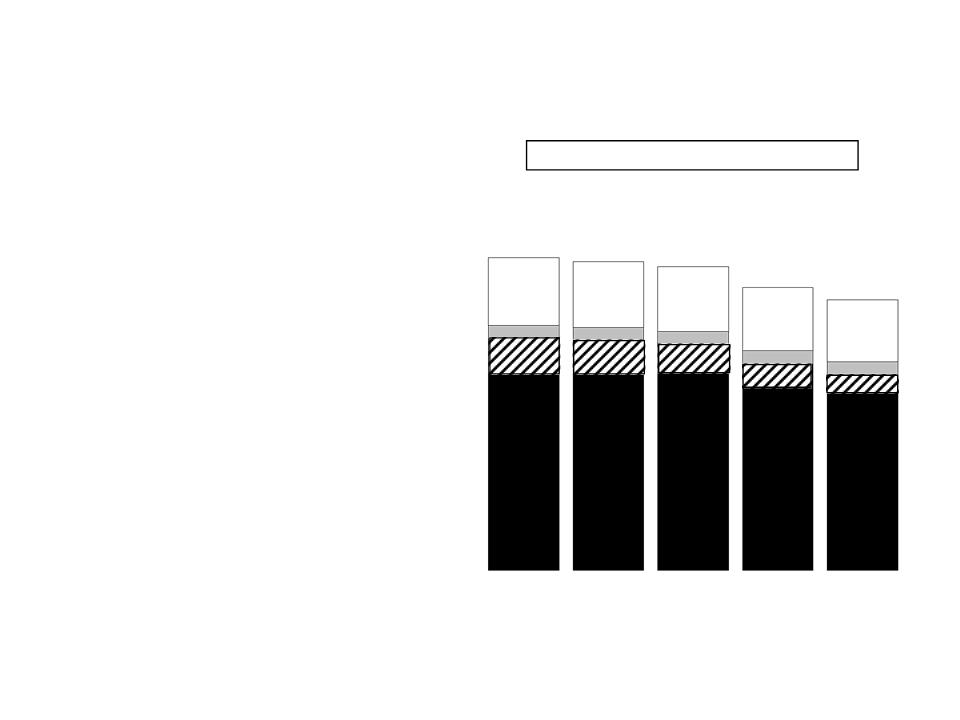
Collected
Premiums
6
CNO
§ Total
collected premiums
for trailing 4 quarters down
13%
for trailing 4 quarters down
13%
§ Decline
at Bankers due to
termination of PFFS
reinsurance contracts and
lower annuity sales, as
expected
termination of PFFS
reinsurance contracts and
lower annuity sales, as
expected
§ Consistent
growth at
Colonial Penn
Colonial Penn
§ Slight
decline at CIG
primarily due to impact of
2009 reinsurance ceded to
Wilton Re
primarily due to impact of
2009 reinsurance ceded to
Wilton Re
($
millions)
CP
CIG
Collected
Premiums-Trailing 4 Quarters
Q1
2009
$4,549.3
Q2
2009
$4,494.9
Q3
2009
$4,423.1
Q4
2009
$4,114.8
BLC
OTHER
Q1
2010
$3,937.2
BLC
PFFS

Q1
2010
Summary
of Results
7
CNO
$53.2
5.3
25.7
(24.5)
59.7
(1.8)
(4.8)
$53.1
Pre-Tax
After
Tax
EPS
($
millions, except per-share amounts)
$38.2
(1.2)
(3.1)
$33.9
$0.14
(0.00)
(0.01)
$0.13
*Management believes
that an analysis of earnings before net realized investment gains (losses) and
loss on
extinguishment or modification of debt (a non-GAAP financial measure) provides an alternative measure of the operating
results of the company because such items are unrelated to the company’s continuing operations. The table above
provides a reconciliation to the corresponding GAAP measure.
extinguishment or modification of debt (a non-GAAP financial measure) provides an alternative measure of the operating
results of the company because such items are unrelated to the company’s continuing operations. The table above
provides a reconciliation to the corresponding GAAP measure.
Bankers
Life
Colonial
Penn
Conseco
Insurance Group
Corporate operations
and interest expense
Income
before net realized investment losses
and
valuation allowance for deferred tax assets*
Loss on
extinguishment of debt
Net
realized investment losses
Total
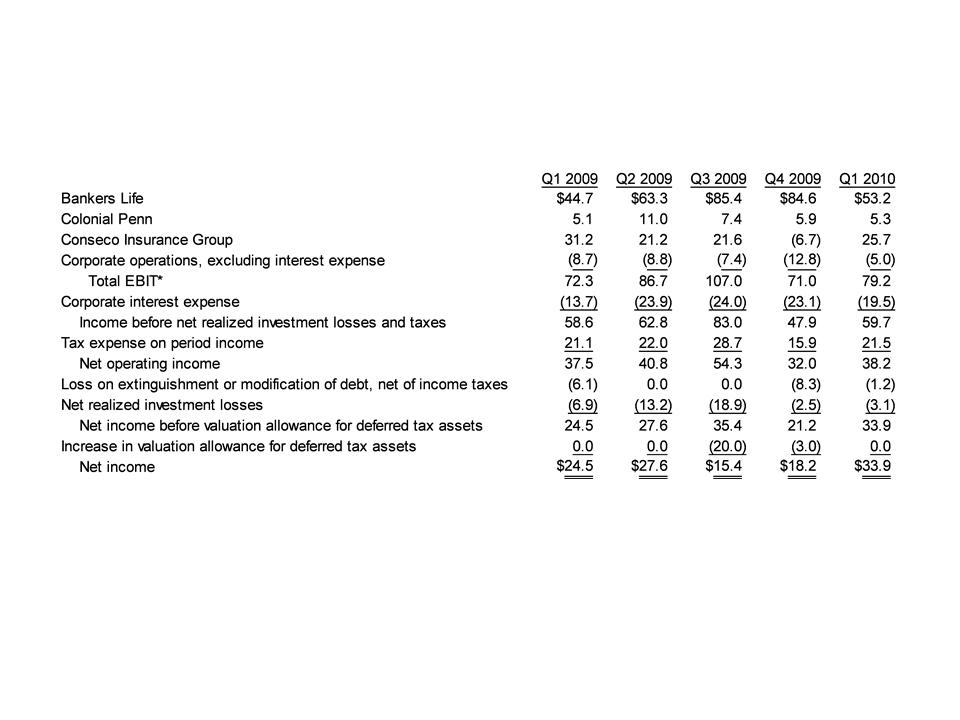
Quarterly
Earnings
8
CNO
Consolidated
*Management believes
that an analysis of earnings before net realized investment gains (losses),
corporate interest,
loss on extinguishment or modification of debt and taxes (“EBIT,” a non-GAAP financial measure) provides a clearer
comparison of the operating results of the company quarter-over-quarter because it excludes: (1) corporate interest
expense; (2) loss on extinguishment or modification of debt; and (3) net realized investment gains (losses) that are
unrelated to the company’s underlying fundamentals. The table above provides a reconciliation of EBIT to net income.
loss on extinguishment or modification of debt and taxes (“EBIT,” a non-GAAP financial measure) provides a clearer
comparison of the operating results of the company quarter-over-quarter because it excludes: (1) corporate interest
expense; (2) loss on extinguishment or modification of debt; and (3) net realized investment gains (losses) that are
unrelated to the company’s underlying fundamentals. The table above provides a reconciliation of EBIT to net income.
($
millions)
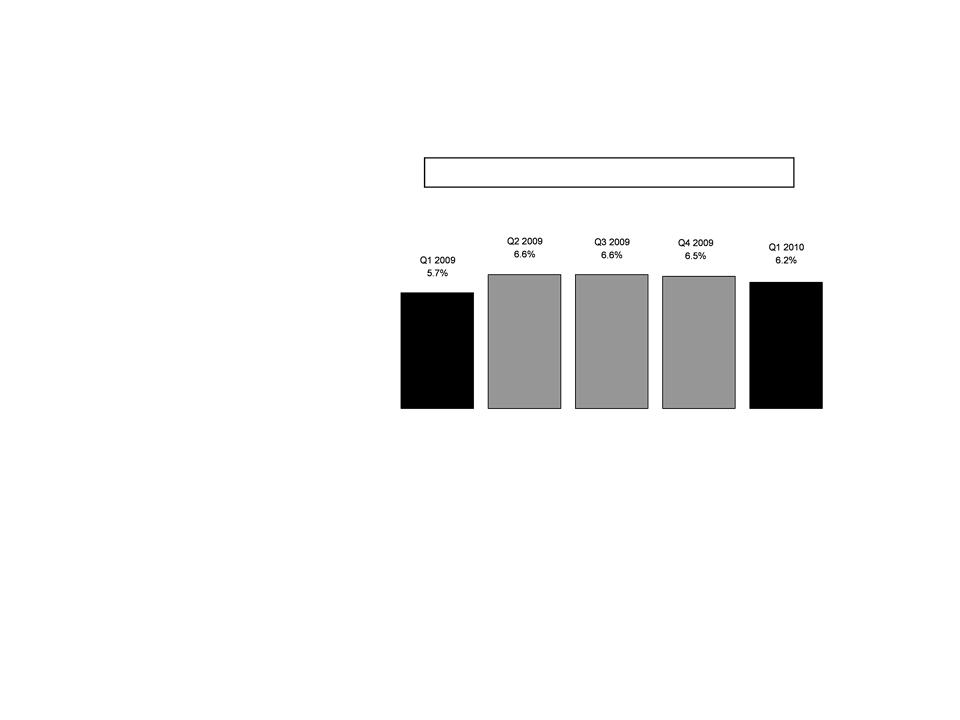
Operating
ROE
9
CNO
Operating ROE*,
Trailing 4 Quarters
*Operating return
excludes gain (loss) on extinguishment or modification of debt, net realized
investment gains
(losses), valuation allowance related to deferred tax assets and discontinued operations. Equity excludes
accumulated other comprehensive income (loss) and the value of net operating loss carryforwards. See
Appendix for corresponding GAAP measure.
(losses), valuation allowance related to deferred tax assets and discontinued operations. Equity excludes
accumulated other comprehensive income (loss) and the value of net operating loss carryforwards. See
Appendix for corresponding GAAP measure.
|
Average common
shareholders’ equity,
excluding AOCL and net operating loss carryforwards, trailing 4 quarters ($ millions): |
$2,702.0
|
$2,574.1
|
$2,503.9
|
$2,551.1
|
$2,679.2
|
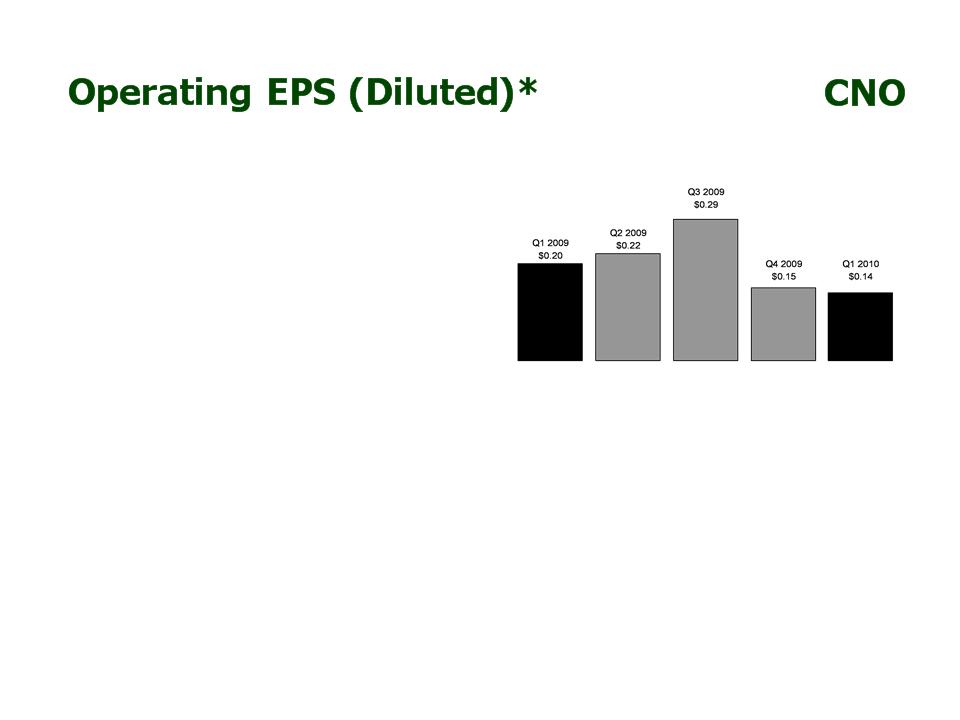
10
*Operating earnings
per share exclude loss on extinguishment or modification of debt, net realized
investment
gains
(losses) and valuation allowance related to deferred tax assets. See
Appendix for a reconciliation to the
corresponding GAAP
measure.
|
Weighted
average diluted shares (in millions):
|
184.8
|
185.2
|
185.8
|
217.5
|
292.1
|
§ Q1
2010 reflects dilution from
issuance of 65.9 million shares
of common stock and $240.5
million of convertible
debentures
issuance of 65.9 million shares
of common stock and $240.5
million of convertible
debentures

Book
Value
11
CNO
*See
Appendix for a reconciliation to the corresponding GAAP measure.
Shareholders’ Equity
(excluding AOCL)
Accumulated Other
Comprehensive Loss
Total
Shareholders’ Equity
Shares
Outstanding
Book
Value Per Share
Book
Value Per Share (Excluding AOCL)
$3,431.7
(1,840.5)
$1,591.2
184.8
$8.61
$18.57
3/31/09
$3,461.9
(1,046.9)
$2,415.0
184.9
$13.06
$18.72
6/30/09
$3,479.7
(146.0)
$3,333.7
184.9
$18.03
$18.82
9/30/09
$3,796.7
(264.3)
$3,532.4
250.8
$14.09
$15.14
12/31/09
($
millions, except per-share amounts)
$3,823.1
(103.0)
$3,720.1
250.9
$14.83
$15.24
3/31/10
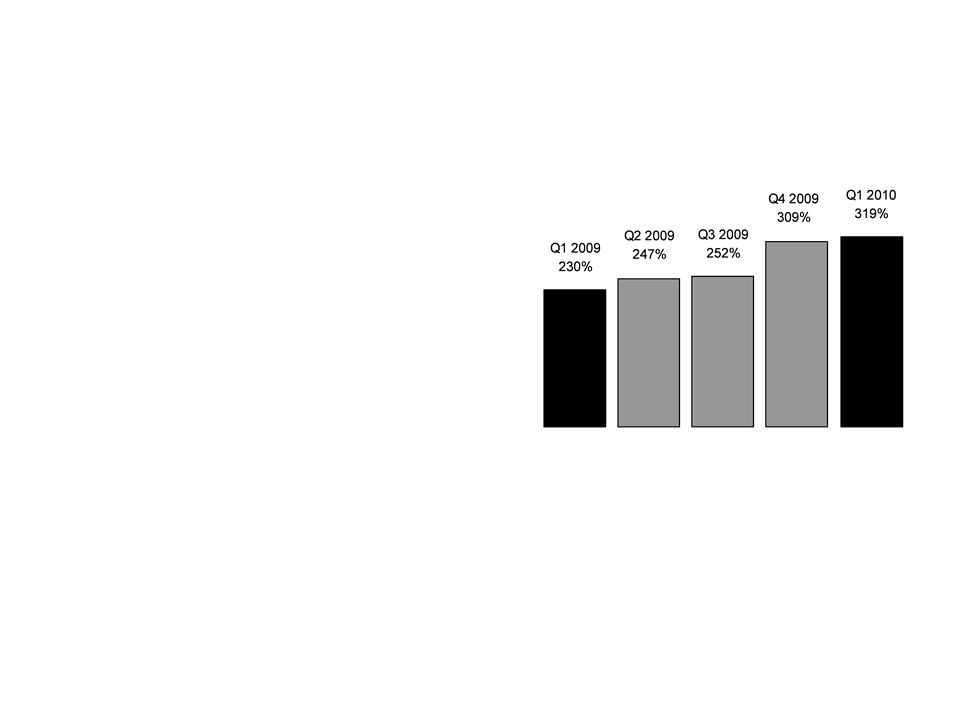
Consolidated
RBC Ratio*
12
CNO
*Risk-Based Capital
(“RBC”) requirements provide a tool for insurance regulators to determine the
levels of
statutory
capital and surplus an insurer must maintain in relation to its insurance and
investment risks. The
RBC
ratio is the ratio of the statutory consolidated adjusted capital of our
insurance subsidiaries to RBC.
§ RBC
ratio continues to improve
§ Primarily
driven by Q1 2010
statutory earnings
statutory earnings

Q1
Summary
13
Bankers
§ Earnings
of $53.2 million, up 19%
• Higher Life income
due to:
• Favorable mortality
(+$5 million)
• Reserve changes from
Q1 2009 (+$5 million)
• Lost earnings from
blocks reinsured in 2009 (-$3 million)
• Higher PFFS/PDP
income due to:
• Favorable PFFS IBNR
development (+$2 million)
• Higher PDP margins
(+$1 million)
§ NAP
up 1%
§ Stable
agent count; improved agent productivity

Bankers
14
($
millions)
Quarterly
NAP*
*PFFS
and PDP sales are not comparable and are excluded from NAP in all periods; in
addition, we no longer
assume any of the risks on PFFS contracts through reinsurance.
assume any of the risks on PFFS contracts through reinsurance.
|
PFFS policies
issued:
|
19.3
|
1.8
|
-0.2
|
-1.0
|
22.8
|
|
PDP policies
issued:
|
18.3
|
3.8
|
3.8
|
1.3
|
8.0
|
Policies issued and
not included in NAP (net of chargebacks, in thousands):
Sales
& Distribution Results
§ NAP
up 1%
• Increases in Life
(+25%), LTC (+14%)
and Med Supp (+5%), offset by
and Med Supp (+5%), offset by
• Lower sales of
Annuities (-25%),
consistent with overall industry results
and driven by lower market interest
rates
consistent with overall industry results
and driven by lower market interest
rates

Medicare
Sales Update
15
Bankers
Q4
2008-
Q1
2009
Q4
2009-
Q1
2010
Medicare
Supplement
Med
Advantage/
PFFS
Issued
Policies
18,902
24,120
21,819
43,086
+79%
+15%
PDP
19,391
9,191
-53%
§ Strong
growth in Med Supp/
Med Advantage sales for Q4
2009-Q1 2010 period vs Q4
2008-Q1 2009
Med Advantage sales for Q4
2009-Q1 2010 period vs Q4
2008-Q1 2009
• Med Supp issued
policies up 79%
• Med Advantage/PFFS
up 15%
• PDP down
53%
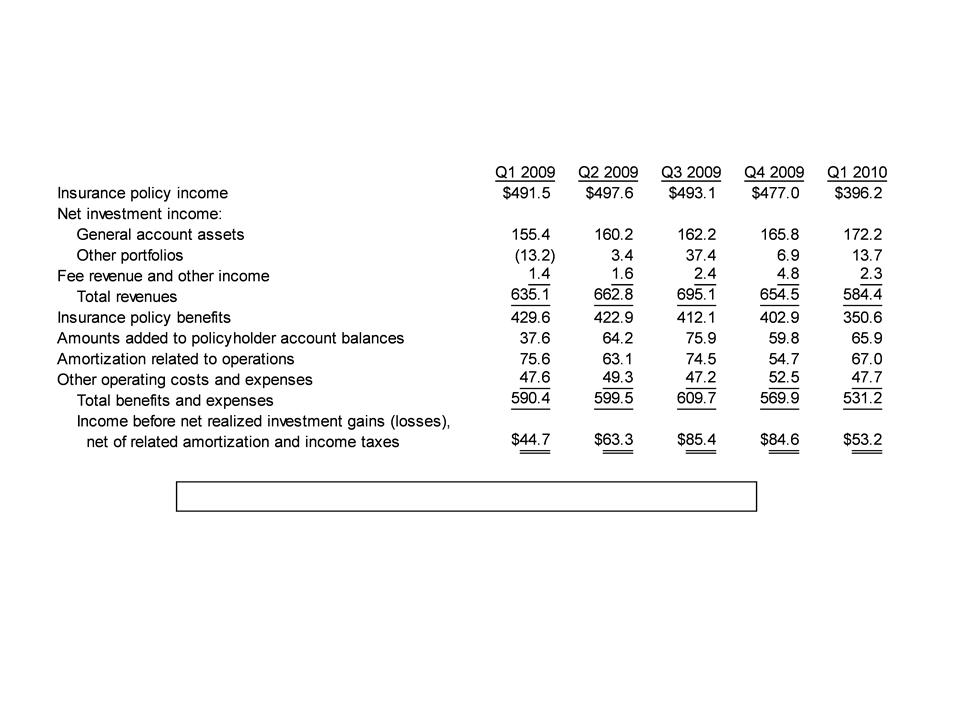
Q1
Earnings
16
Bankers
($
millions)
Trailing
4 Quarter Operating Return on Equity: 11.8%
Management believes
that an analysis of income before net realized investment gains (losses), net of
related
amortization (a non-GAAP financial measure), is important to evaluate the financial performance of our
business, and is a measure commonly used in the life insurance industry. Management uses this measure to
evaluate performance because realized gains or losses can be affected by events that are unrelated to a
company’s underlying fundamentals. The table on Page 8 reconciles the non-GAAP measure to the
corresponding GAAP measure. See Appendix for a reconciliation of the return on equity measure to the
corresponding GAAP measure.
amortization (a non-GAAP financial measure), is important to evaluate the financial performance of our
business, and is a measure commonly used in the life insurance industry. Management uses this measure to
evaluate performance because realized gains or losses can be affected by events that are unrelated to a
company’s underlying fundamentals. The table on Page 8 reconciles the non-GAAP measure to the
corresponding GAAP measure. See Appendix for a reconciliation of the return on equity measure to the
corresponding GAAP measure.

Q1
Summary
17
Colonial
Penn
§ Earnings
of $5.3 million, up 4%
• Primarily due to
favorable mortality and growth in our block of life
insurance policies
insurance policies
§ Sales
(NAP) up 7%
• Lead generation
momentum building following 2009 capital limitations
• Increased lead
activity will drive return to pre-2009 sales levels
• NAP from lead-based
programs up 32% over Q1 2009, and up 76% over
Q4 2009
Q4 2009
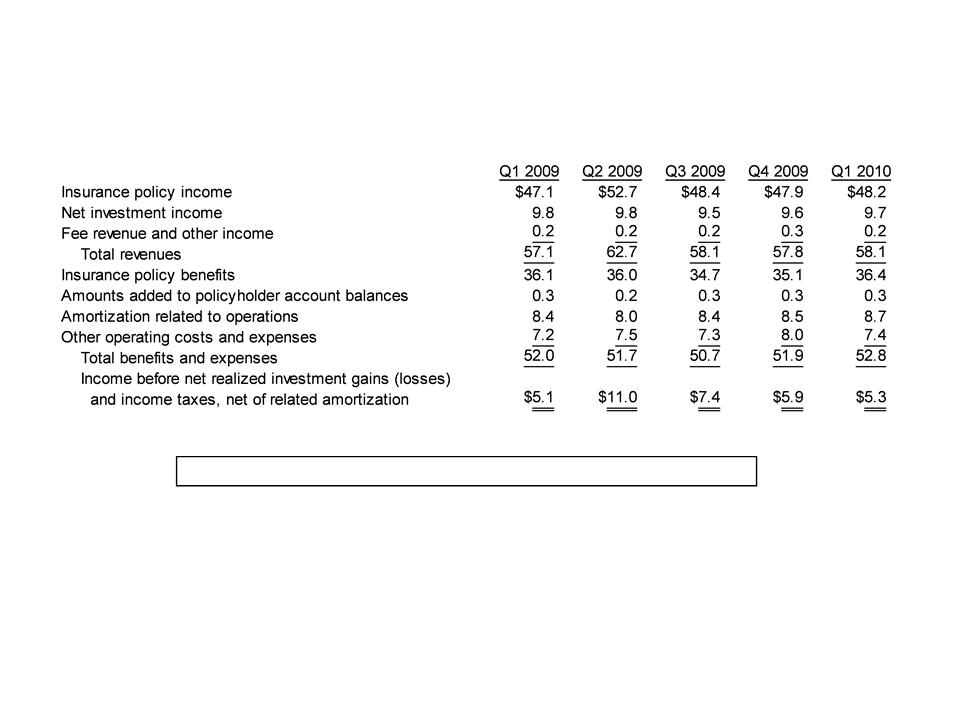
Q1
Earnings
18
Colonial
Penn
($
millions)
Trailing
4 Quarter Operating Return on Equity: 14.0%
Management believes
that an analysis of income before net realized investment gains (losses), net of
related
amortization (a non-GAAP financial measure), is important to evaluate the financial performance of our
business, and is a measure commonly used in the life insurance industry. Management uses this measure to
evaluate performance because realized gains or losses can be affected by events that are unrelated to a
company’s underlying fundamentals. The table on Page 8 reconciles the non-GAAP measure to the
corresponding GAAP measure. See Appendix for a reconciliation of the return on equity measure to the
corresponding GAAP measure.
amortization (a non-GAAP financial measure), is important to evaluate the financial performance of our
business, and is a measure commonly used in the life insurance industry. Management uses this measure to
evaluate performance because realized gains or losses can be affected by events that are unrelated to a
company’s underlying fundamentals. The table on Page 8 reconciles the non-GAAP measure to the
corresponding GAAP measure. See Appendix for a reconciliation of the return on equity measure to the
corresponding GAAP measure.

Q1
Summary
19
CIG
§ NAP
of $16.7 million, up 12%
• Third consecutive
quarter of positive sales comparisons
§ Strong
sales growth in both CIG Sales and PMA
§ Strong
recruiting results
§ Earnings
of $25.7 million, down 18%
• Lower Specified
Disease income due primarily to reserve
releases in Q1 2009 (-$5 million)
releases in Q1 2009 (-$5 million)
• Lower Life income
due primarily to lost earnings on blocks
reinsured in 2009 (-$5 million)
reinsured in 2009 (-$5 million)
• Higher Annuity
income due to return to normal surrender activity
for indexed annuity products in Q1 2010 (+$6 million)
for indexed annuity products in Q1 2010 (+$6 million)

CIG
($
millions)
§ Specified
Disease sales up 28%
§ New
worksite groups up 64%
Q1
2009
Q1
2010
Q1
2010 Sales Results

Q1
Earnings
21
CIG
Management believes
that an analysis of income (loss) before net realized investment gains (losses),
net of
related amortization (a non-GAAP financial measure), is important to evaluate the financial performance of
our business, and is a measure commonly used in the life insurance industry. Management uses this
measure to evaluate performance because realized gains or losses can be affected by events that are
unrelated to a company’s underlying fundamentals. The table on Page 8 reconciles the non-GAAP measure
to the corresponding GAAP measure.
related amortization (a non-GAAP financial measure), is important to evaluate the financial performance of
our business, and is a measure commonly used in the life insurance industry. Management uses this
measure to evaluate performance because realized gains or losses can be affected by events that are
unrelated to a company’s underlying fundamentals. The table on Page 8 reconciles the non-GAAP measure
to the corresponding GAAP measure.
($
millions)

Realized
Gains/Losses Recognized
Through
Net Income
22
CNO
Gross
gains
Gross
losses
Losses
due to recognition of other-than-tempor-
ary
impairments recognized in earnings
Amortization
adjustment to insurance intangibles
Net
investment losses before tax
Income
tax benefit
Net
investment losses after tax
($
millions)
$89.5
(4.4)
(92.0)
0.0
(6.9)
0.0
$(6.9)
Q1
2009
$83.6
(63.3)
(36.6)
3.1
(13.2)
0.0
$(13.2)
Q2
2009
$99.5
(84.1)
(35.7)
1.4
(18.9)
0.0
$(18.9)
Q3
2009
$110.5
(96.4)
(31.1)
(0.5)
(17.5)
15.0
$(2.5)
Q4
2009
$50.9
(35.5)
(20.3)
0.1
(4.8)
1.7
$(3.1)
Q1
2010
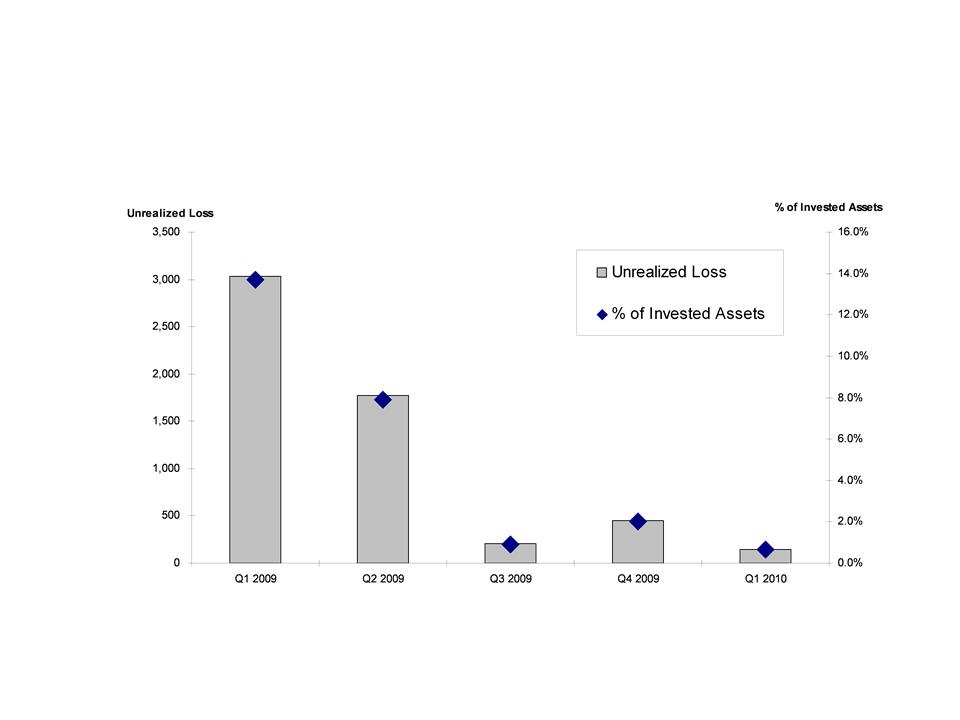
Unrealized
Gain/Loss*
23
CNO
($
millions)
*Includes debt and
equity securities classified as available for sale. Excludes
investments from variable
interest entities
which we consolidate under GAAP.

Q1
2010 Impairments
24
CNO
Corporates
Alt-A
Prime
Jumbos
Commercial Mortgage
Loans
Other
Total
($
millions)
Gross
Amounts
Amount
Recognized
through Accumulated
Other Comprehensive
Loss
through Accumulated
Other Comprehensive
Loss
Amount
Recognized
through Net Income
through Net Income
$1.2
5.0
0.7
10.9
2.5
$20.3
$0.0
(1.9)
(0.7)
0.0
0.0
$(2.6)
$1.2
3.1
0.0
10.9
2.5
$17.7
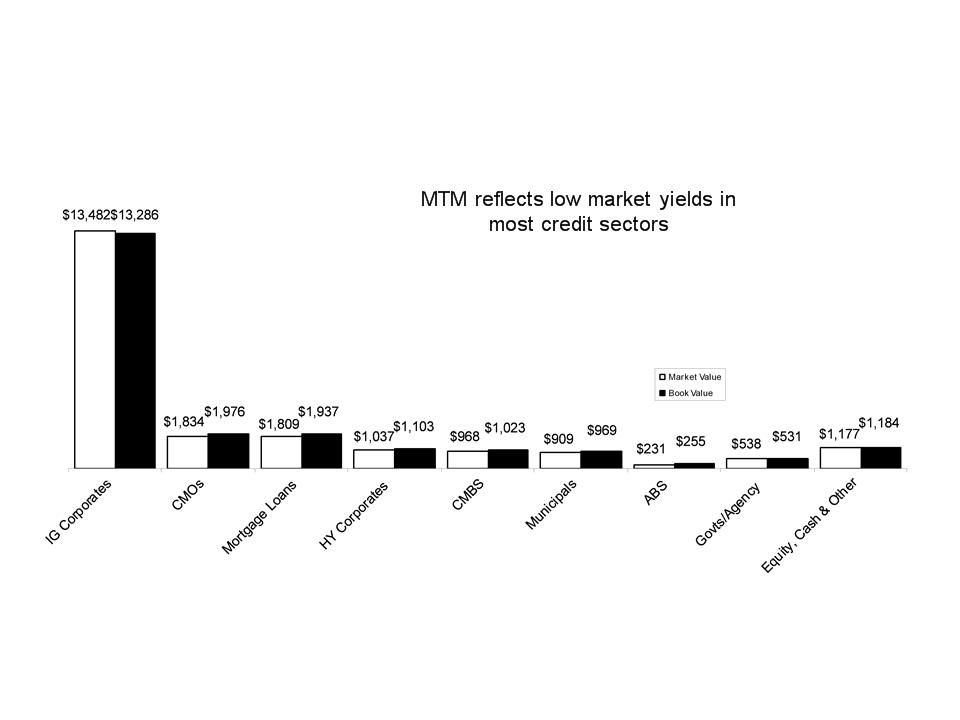
Asset
Allocation at 3/31/10*
25
CNO
($
millions)
*Excludes
investments from variable interest entities which we consolidate under GAAP (the
related liabilities are
non-recourse to
Conseco).
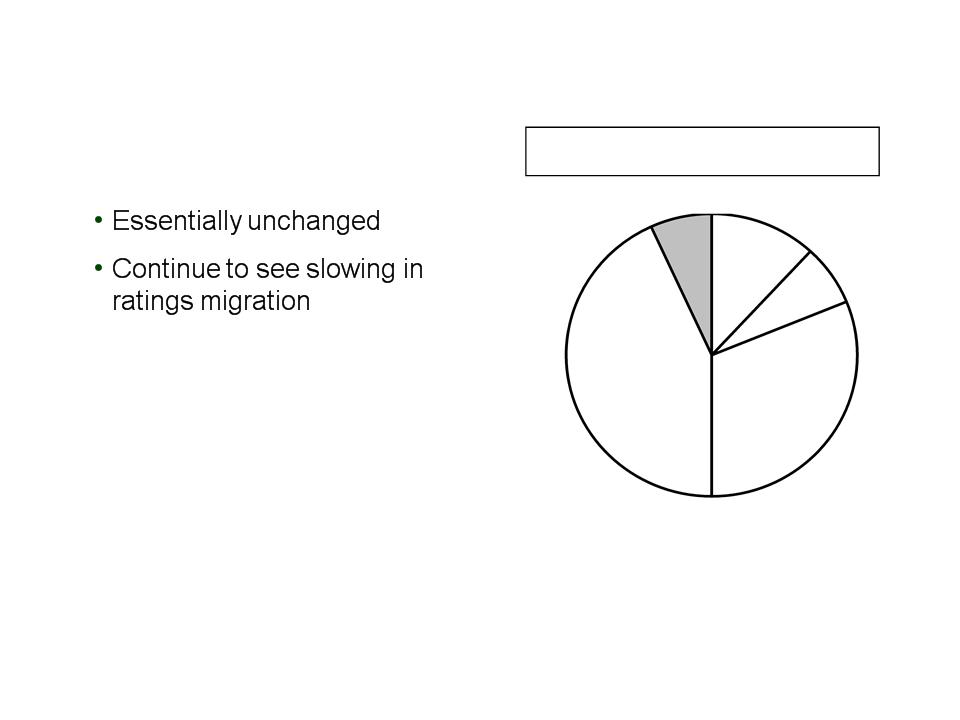
Investment
Quality:
Fixed
Maturities*
26
CNO
Actively Managed
Fixed Maturities by Rating at
3/31/10 (Market Value)
3/31/10 (Market Value)
|
%
of Bonds which are Investment Grade:
|
3/31/09
91%
|
6/30/09
91%
|
9/30/09
93%
|
12/31/09
93%
|
3/31/10
93%
|
*Excludes
investments from variable interest entities which we consolidate under GAAP (the
related liabilities are
non-recourse to
Conseco).
AAA
12%
AA
7%
A
31%
BBB
43%
7%
§ 93%
investment grade:

Alt-A
at 3/31/10
CNO
27
AAA
AA
A
Total
$4.2
$53.9
$16.2
$140.9
$215.2
$4.2
$56.9
$16.5
$182.6
$260.2
2.0%
25.0%
7.5%
65.5%
100.0%
0.02%
0.24%
0.07%
0.65%
0.98%
Market
Value
(mil.)
Book
Value
(mil.)
%
of
Alt-A*
%
of
Portfolio*
Rating
§ 0.98% of total
invested assets
§ Collateral
performing better than overall Alt-A market in terms of delinquency and
accumulated
loss trends
loss trends
§ All securities
evaluated using market-consistent estimates of collateral
performance
§ Relating to recovery
of book values, adequate credit support to expected cumulative
losses
720
707
721
710
710
Avg.
FICO
FICO
10.9%
13.0%
9.8%
9.2%
10.2%
Avg.
Support
6.5%
9.0%
8.7%
24.3%
18.9%
Avg.
60+
Delinq.
*Market
value.
($
millions)
0.3%
0.7%
0.3%
2.6%
1.9%
Avg.
Accum.
Loss

Prime
Jumbo at 3/31/10
CNO
28
AAA
AA
A
BBB
Total
$129.7
$73.0
$161.1
$47.2
$208.2
$619.2
$141.0
$76.6
$176.6
$53.2
$263.3
$710.7
21.0%
11.8%
26.0%
7.6%
33.6%
100.0%
0.59%
0.33%
0.73%
0.21%
0.96%
2.82%
Market
Value
(mil.)
Book
Value
(mil.)
%
of
Prime
Jumbo*
Jumbo*
%
of
Portfolio*
Rating
§ 2.82% of total
invested assets
§ All securities
evaluated using market-consistent estimates of collateral
performance
§ Credit support
remains substantial relative to anticipated cumulative losses
736
744
740
743
738
739
Avg.
FICO
FICO
6.6%
7.6%
8.2%
7.4%
6.2%
7.0%
Avg.
Support
2.7%
5.2%
4.9%
7.0%
12.0%
7.0%
Avg.
60+
Delinq.
*Market
value.
($
millions)
0.07%
0.36%
0.35%
0.67%
0.98%
0.53%
Avg.
Accum.
Loss
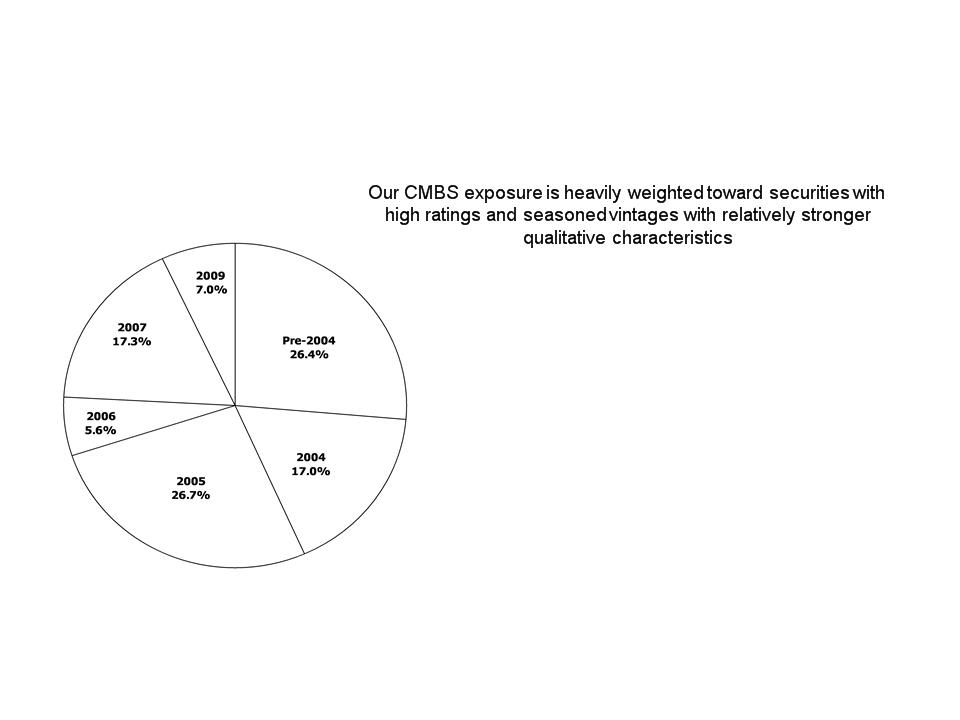
CMBS
at 3/31/10
29
CNO
(GAAP
book value - $ millions)
$200.8
$136.4
$208.3
$24.9
$176.5
$71.3
$818.2
$833.9
$26.3
$10.1
$22.0
$14.7
$0.0
$0.0
$73.1
$62.8
$37.4
$10.6
$5.9
$0.0
$0.0
$0.0
$53.9
$39.3
$5.9
$17.3
$13.1
$18.1
$0.0
$0.0
$54.4
$25.6
$0.0
$0.0
$23.3
$0.0
$0.0
$0.0
$23.3
$6.8
Pre-2004
2004
2005
2006
2007
2009
Total
BV
Total
MV
AAA
AA
A
BBB

CMBS
at 3/31/10
CNO
30
AAA
AA
A
BBB
Total
$833.9
$62.8
$39.3
$25.6
6.8
$968.4
$818.2
$73.1
$53.9
$54.4
$23.3
$1,022.9
86.1%
6.5%
4.1%
2.6%
0.7%
100.0%
3.78%
0.29%
0.18%
0.12%
0.03%
4.40%
Market
Value
(mil.)
Book
Value
(mil.)
%
of
CMBS*
%
of
Portfolio*
Rating
§ 4.40% of invested
assets
§ Collateral
performing materially better than overall CMBS market in terms of delinquency
and
cumulative loss
cumulative loss
§ All securities
evaluated using market-consistent estimates of collateral
performance
§ Substantial credit
support inherent in structures relative to expected cumulative
losses
30.7%
20.7%
8.4%
7.7%
4.0%
28.3%
Avg.
Support
3.4%
1.3%
1.1%
2.1%
1.3%
3.1%
Avg.
60+
Del.
& FCR
*% of
market value
($
millions)
0.32%
0.09%
0.15%
0.01%
0.08%
0.29%
Avg.
Cum.
Loss
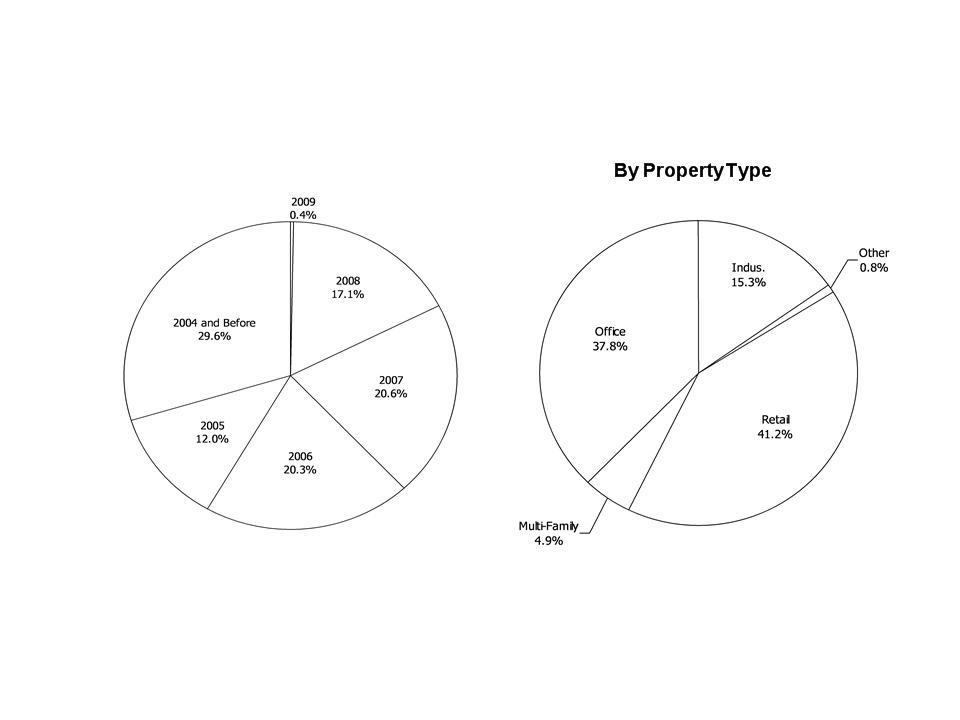
Commercial
Mortgage Loans
at
3/31/10
By
Vintage
31
CNO
§ Current LTV of
approximately 63%
§ Trailing debt
service coverage ratio (DSCR) stable at approximately 1.53
§ Three delinquent
loans at 3/31/10, totaling $12 million

CNO
Summary
32
CNO
§ Core
sales and lead generation continue to be strong
§ Impact
of health care reform
• Medicare Supplement
and Medicare Advantage
• Potential
opportunities in Supplemental Health market
§ Demographics
are trending favorably
• First of Boomer
population will become Medicare-eligible in 2011;
in 10 years, number of those 65 and older will increase by 50%
in 10 years, number of those 65 and older will increase by 50%
§ Focus:
• Improve results of
underperforming blocks in new “Other CNO
Business” segment
Business” segment
• Drive sales growth
in all channels
§ Expect
to launch CNO Financial Group investor brand on May 12

33
Questions
and Answers

34
Appendix

Statutory
Surplus ($ millions)
*Also applicable in
2010 for Debt to Capital ratio only.
**Excludes
Accumulated Other Comprehensive Loss, as defined by the senior credit
facility.
$1,200
$1,100
Prior
Amendment Level
New
2011 Level*
New
2012 Level
CNO
35
250%
200%
1.5x
2.0x
1.75x
225%
$1,300
Covenant
Metrics

Q1
2010 Liquidity
36
CNO
($
millions)
Cash
Balance 12/31/09
Sources
Dividends
from insurance subsidiary
Net
Proceeds from New Convertible Debentures
Surplus
Debenture Interest
Management
and Investment Fees and Other
Total
Sources
Uses
Interest
Debt
Repayments:
Retirement
of Old Convertible Debentures
Holding
Company Expenses and Other
Capital
Contributions
Total
Uses
Cash
Balance 3/31/10
$146.1
$25.0
61.4
12.0
6.9
105.3
15.5
64.0
11.3
29.4
120.2
$131.2
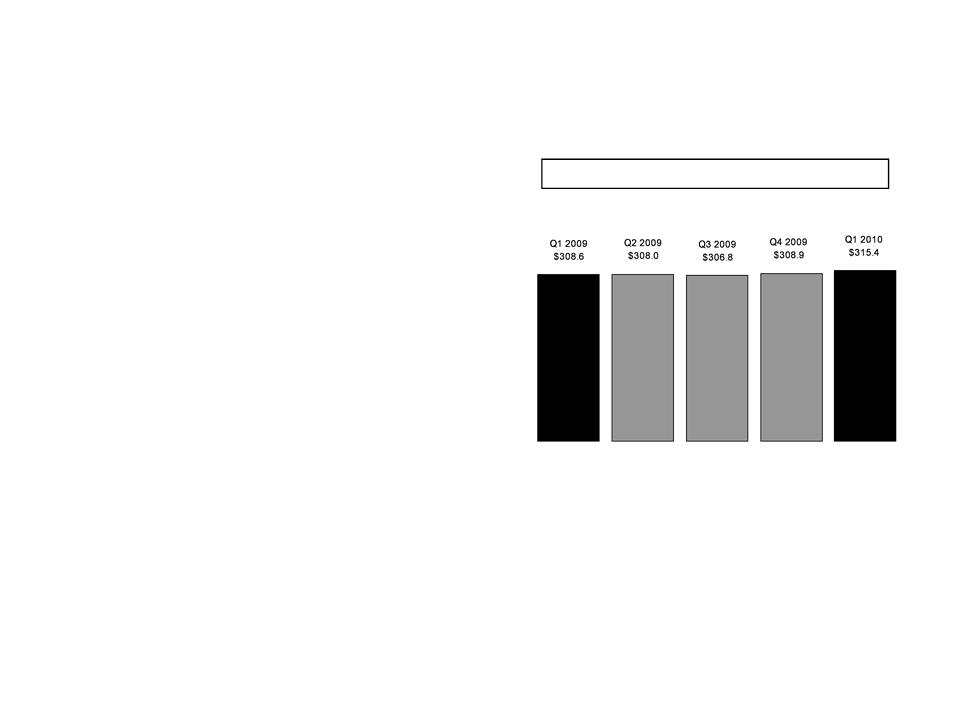
Net
Investment Income
37
CNO
($
millions)
General
Account Investment Income
|
Yield:
|
5.67%
|
5.65%
|
5.63%
|
5.66%
|
5.76%
|
§ Q1
2010 increase in yield due
primarily to higher call
premiums on fixed maturities
primarily to higher call
premiums on fixed maturities

Commercial
Mortgage Loans
at
3/31/10
Geographic
Distribution
38
CNO
Pacific
9.4%
Mountain
9.4%
West
North
Central
Central
11.9%
West
South
Central
Central
5.9%
East
North
Central
Central
22.1%
East
South
Central
Central
5.4%
New
England
9.2%
Middle
Atlantic
Atlantic
6.4%
South
Atlantic
Atlantic
20.3%
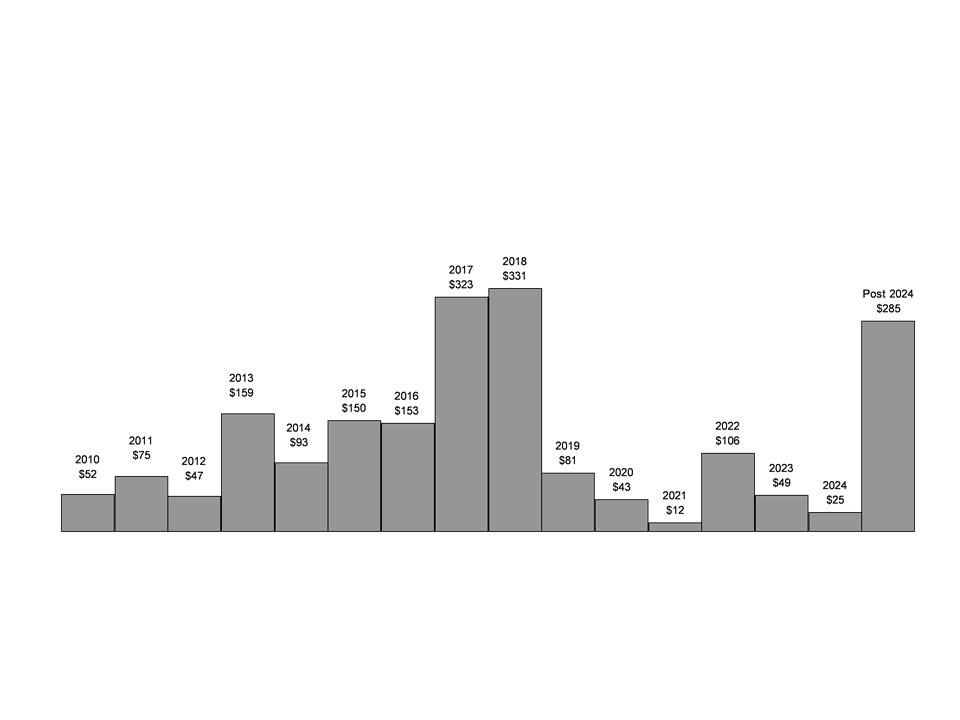
Commercial
Mortgage Loans
at
3/31/10
By
Maturity
39
CNO
($
millions)
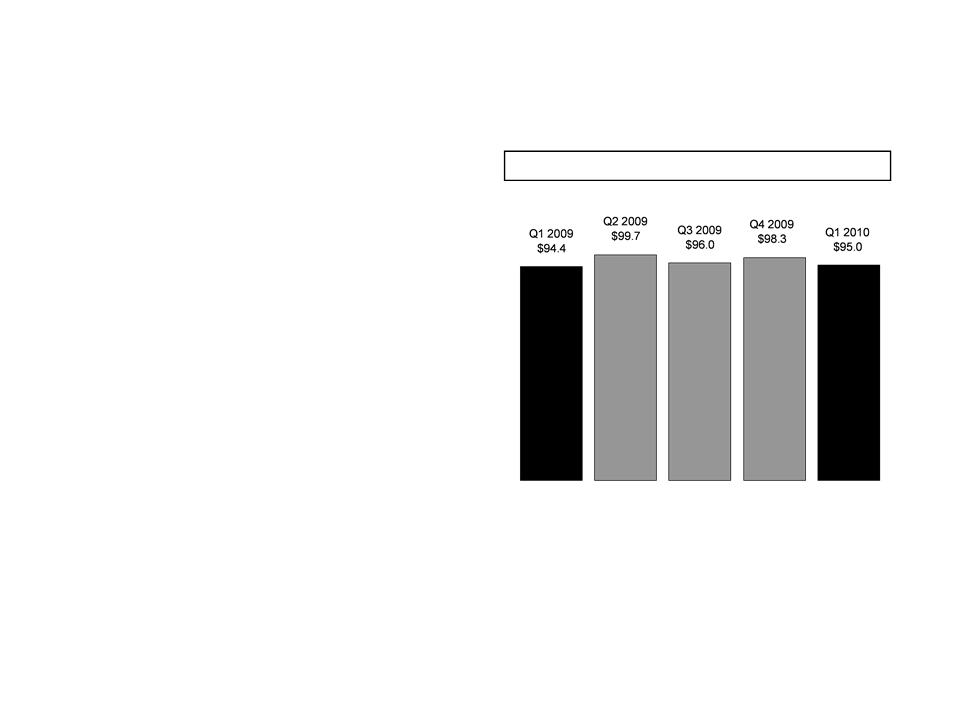
Expenses
40
CNO
($
millions)
Adjusted Operating
Expenses*
*Adjusted operating
expenses exclude primarily acquisition costs, capitalization of software
development
costs, initial PFFS marketing costs and contractual vacancy charges related to exiting the Merchandise Mart
in Chicago. This measure is used by the Company to evaluate its progress in reducing operating expenses.
costs, initial PFFS marketing costs and contractual vacancy charges related to exiting the Merchandise Mart
in Chicago. This measure is used by the Company to evaluate its progress in reducing operating expenses.
§ Q1
2010 expenses returned
to a more stable level after
higher expense in Q4 2009
due to litigation cost, IT
expense and investment in
Operations re-engineering
to a more stable level after
higher expense in Q4 2009
due to litigation cost, IT
expense and investment in
Operations re-engineering

Segment
Performance
41
Bankers
*Operating earnings
exclude net realized gains (losses). See
Appendix for corresponding GAAP measure of
our consolidated results of operations.
our consolidated results of operations.
PTOI-Trailing 4
Quarters: $187.1 $215.8 $233.4 $278.0 $286.5
Revenues-Quarterly: $635.1 $662.8 $695.1 $654.5 $584.4
Pre-Tax
Operating Income*
Revenues -Tr. 4
Quarters: $2,686.3 $2,668.4 $2,684.4 $2,647.5 $2,596.8
($
millions)
§ Earnings
up 19%, positively
affected by:
affected by:
• Higher Life income
due to
favorable mortality and reserve
changes
favorable mortality and reserve
changes
• Higher PFFS/PDP
income due
to favorable IBNR development
and higher PDP margins
to favorable IBNR development
and higher PDP margins
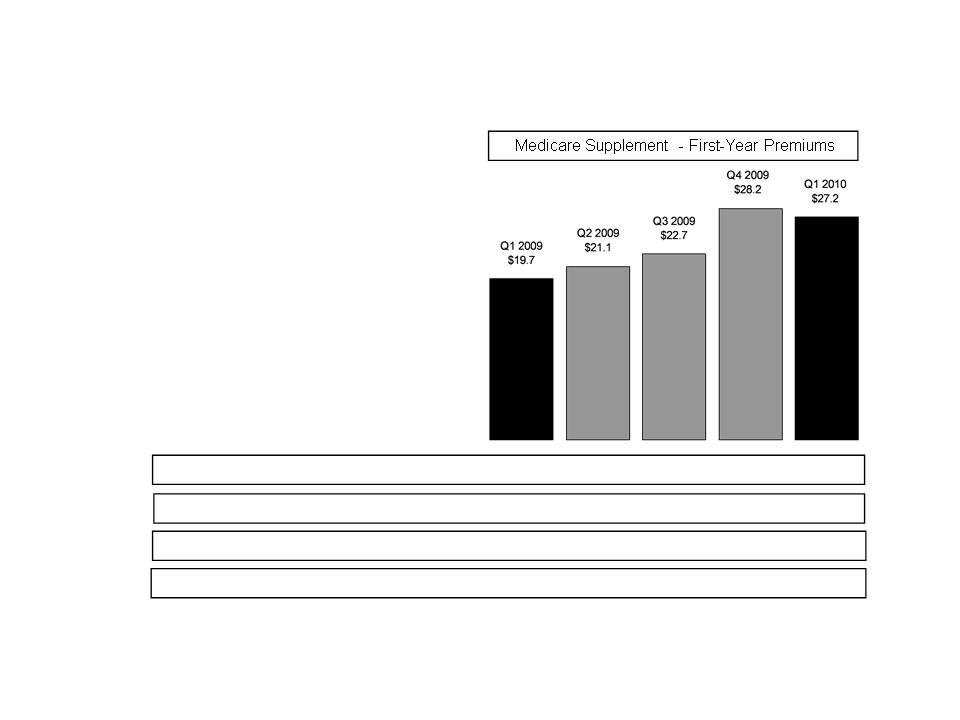
Premiums
-
Medicare
Supplement
42
Bankers
§ First-year
premiums up 38%
Med.
Supp. First-Year Prems.-Tr. 4 Qtrs: $81.9 $83.6 $86.5 $91.7 $99.2
Med.
Supp. Total Premiums-Quarterly: $155.8 $155.2 $168.9 $173.8 $176.6
Med.
Supp. NAP-Quarterly: $18.4 $19.2 $19.9 $56.8 $19.4
Med.
Supp. NAP-Trailing 4 Quarters: $79.9 $82.1 $85.4 $114.3 $115.3
($
millions)
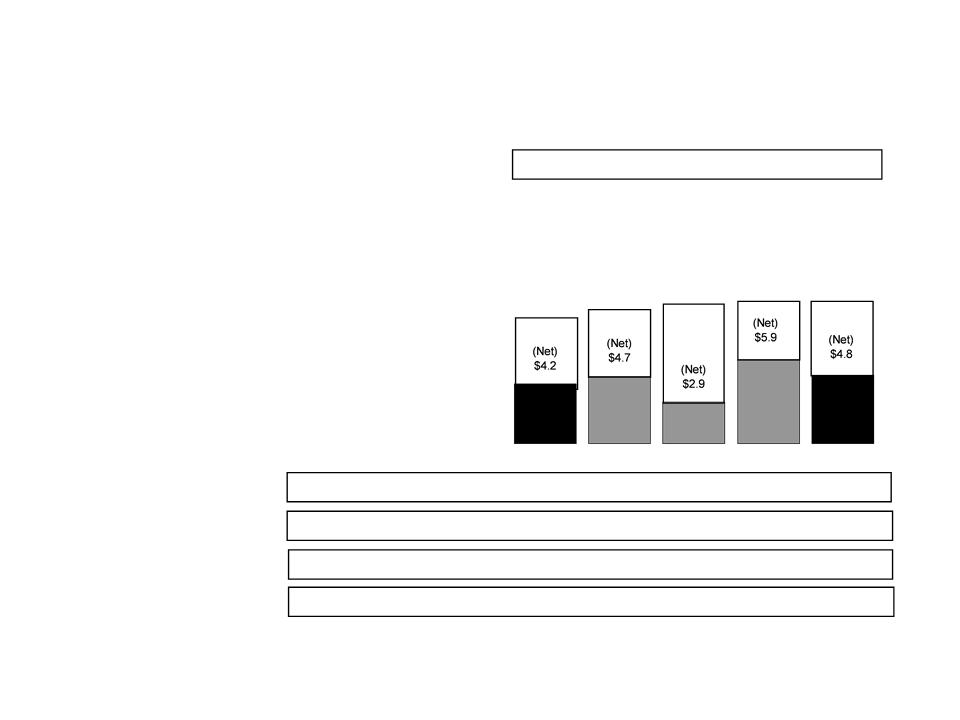
Premiums
-
Long-Term
Care
43
Bankers
($
millions)
First-Year
Prems.-Tr. 4 Qtrs: $35.9 $30.0 $22.1 $17.7 $18.3
Total
Premiums-Quarterly: $145.9 $151.9 $154.3 $149.5 $149.5
Long-Term Care -
First-Year Premiums*
NAP-Quarterly: $7.5 $9.8 $9.8 $8.3 $8.6
NAP-Trailing 4
Quarters: $37.5 $36.6 $35.0 $35.4 $36.5
*Includes $4.4
million in both Q1 2009 and Q2 2009, $6.6 million in Q3 2009, $3.9 million in Q4
2009 and
$5.0
million in Q1 2010 of premiums ceded under new business reinsurance
agreement.
Q2
2009
(Direct)
$9.1
Q1
2009
(Direct)
$8.6
Q3
2009
(Direct)
$9.5
Q4
2009
(Direct)
$9.8
Q1
2010
(Direct)
$9.8
§ First-year
premiums up 14%
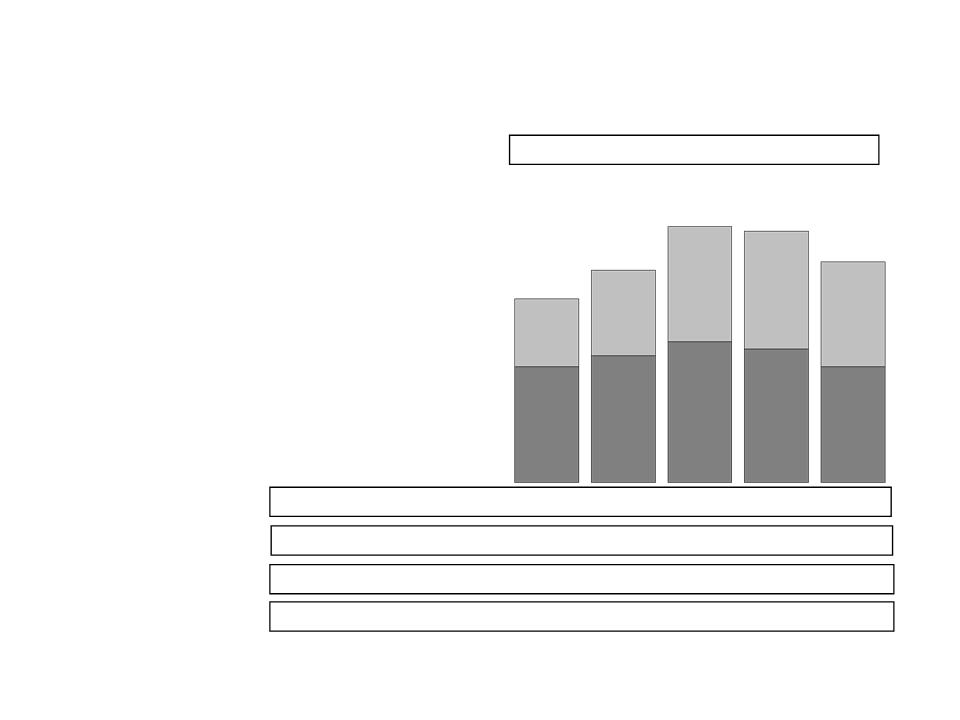
Premiums
-
Life
Insurance
44
Bankers
($
millions)
First-Year
Prems.-Tr. 4 Qtrs: $79.0 $75.9 $79.8 $82.6 $86.0
Total
Premiums-Quarterly: $48.9 $55.3 $63.2 $61.4 $46.5
Life -
First-Year Premiums
NAP-Quarterly: $12.6 $15.6 $15.8 $13.7 $15.8
NAP-Trailing 4
Quarters: $52.8 $52.7 $55.4 $57.7 $60.9
SPWL
Non-
SPWL
Q1
2009
$16.8
$6.2
$10.6
Q2
2009
$19.4
$7.8
$11.6
Q3
2009
$23.4
$10.5
$12.9
Q4
2009
$23.0
$10.8
$12.2
Q1
2010
$20.2
$9.6
$10.6
§ Fluctuations
in first-year
premiums primarily reflect
variance in sales of single
-premium policies
premiums primarily reflect
variance in sales of single
-premium policies
§ Non-SPWL
premiums
even
even
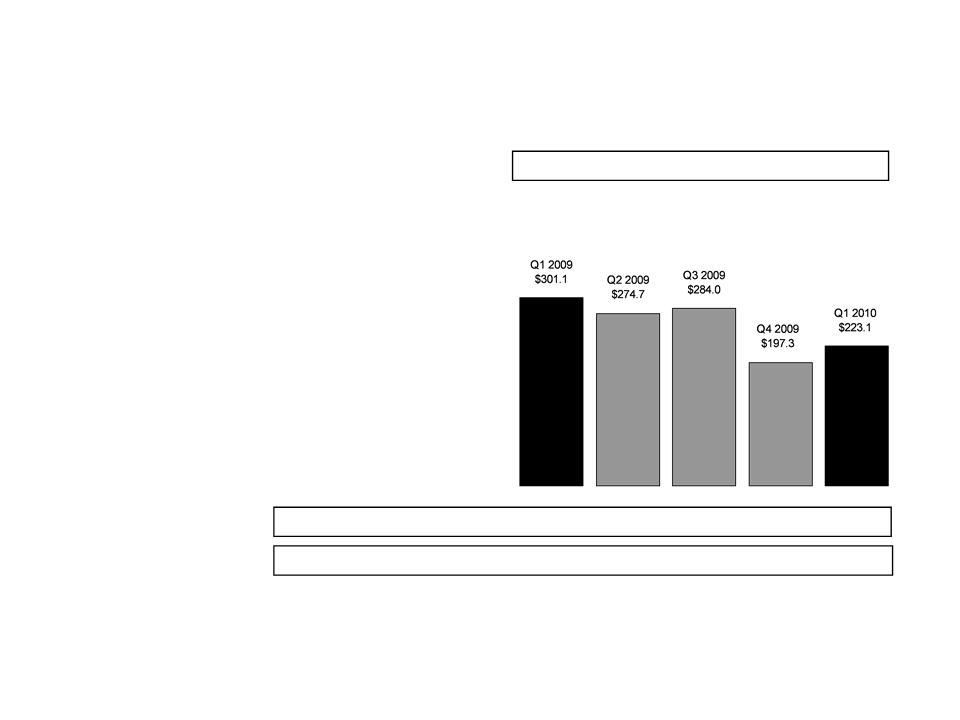
Premiums
-
Annuity
45
Bankers
($
millions)
First-Year
Prems.-Tr. 4 Qtrs: $1,294.1 $1,308.7 $1,270.3 $1,057.1 $979.1
Total
Premiums-Quarterly: $302.1 $275.4 $284.7 $198.2 $224.4
Annuity
- First-Year Premiums
§ First-year
premiums down
26% as result of current
interest rate environment
26% as result of current
interest rate environment
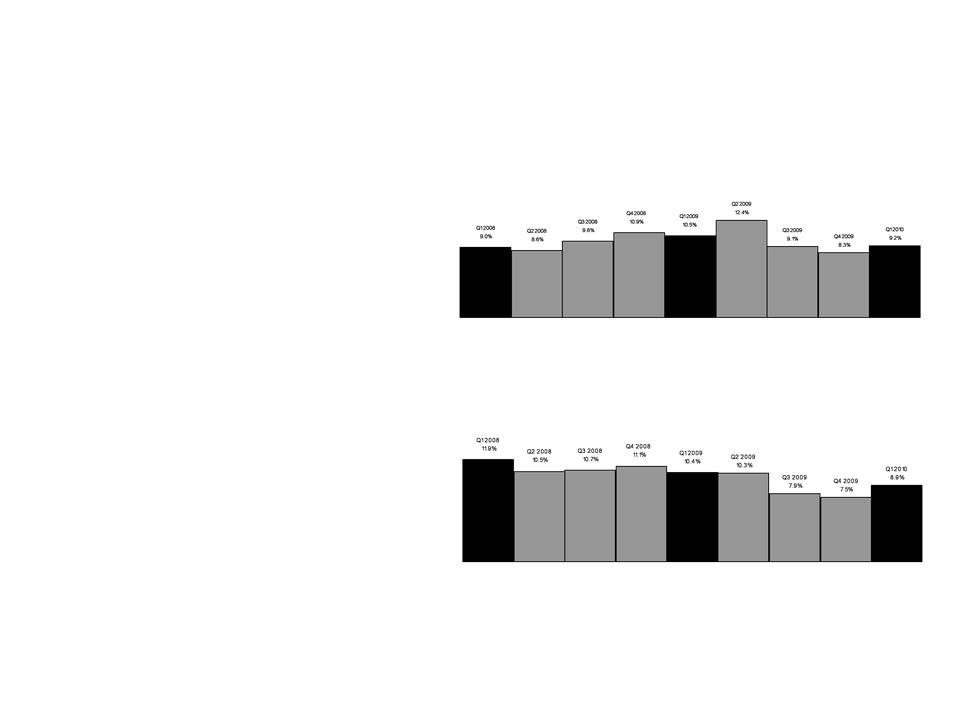
Annuity
Surrenders
46
Bankers
IA
Surrenders
(annualized
quarterly rate)
Non-IA
Surrenders
(annualized
quarterly rate)
§ Surrenders:
both indexed and non-
indexed annuity surrenders lower
than prior year
indexed annuity surrenders lower
than prior year
§ Total
account value:
• IAs - $1.7
billion
• Non-IAs - $4.8
billion
§ Average
account value:
• IAs -
$41,000
• Non-IAs -
$36,000
§ Over
89% of our annuities are
subject to surrender charge:
subject to surrender charge:
• IAs -
95%
• Non-IAs -
86%

Benefit
Ratio* - PDP
47
Bankers
*We
calculate benefit ratios by dividing insurance policy benefits by insurance
policy income.
§ Down
7%, impacted by
improved pricing and plan
design changes
improved pricing and plan
design changes
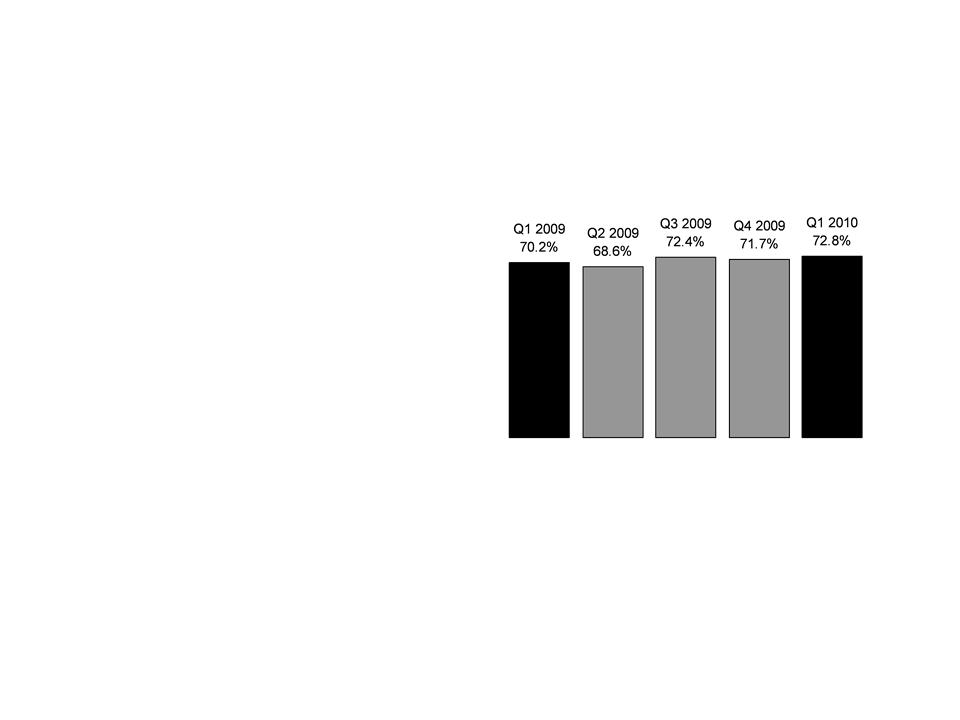
Benefit
Ratio* -
Medicare
Supplement
48
Bankers
*We
calculate benefit ratios by dividing insurance policy benefits by insurance
policy income.
§ Q1
2010 impacted by higher
incurred claims
incurred claims

Interest-Adjusted
Benefit Ratio* -
Long
Term Care
49
Bankers
*We
calculate interest-adjusted benefit ratios by dividing insurance policy benefits
less interest income on
the accumulated assets backing the insurance liabilities by insurance policy income.
the accumulated assets backing the insurance liabilities by insurance policy income.
Trailing 4 Quarter
Avg.: 71.4% 67.6% 68.2% 67.9% 69.6%
Qtrly.
non-int. adjusted: 105.1% 103.2% 108.3% 104.3% 114.4%
§ Q1
2009 impacted by prior-
period rate increase activity
affecting lapses
period rate increase activity
affecting lapses
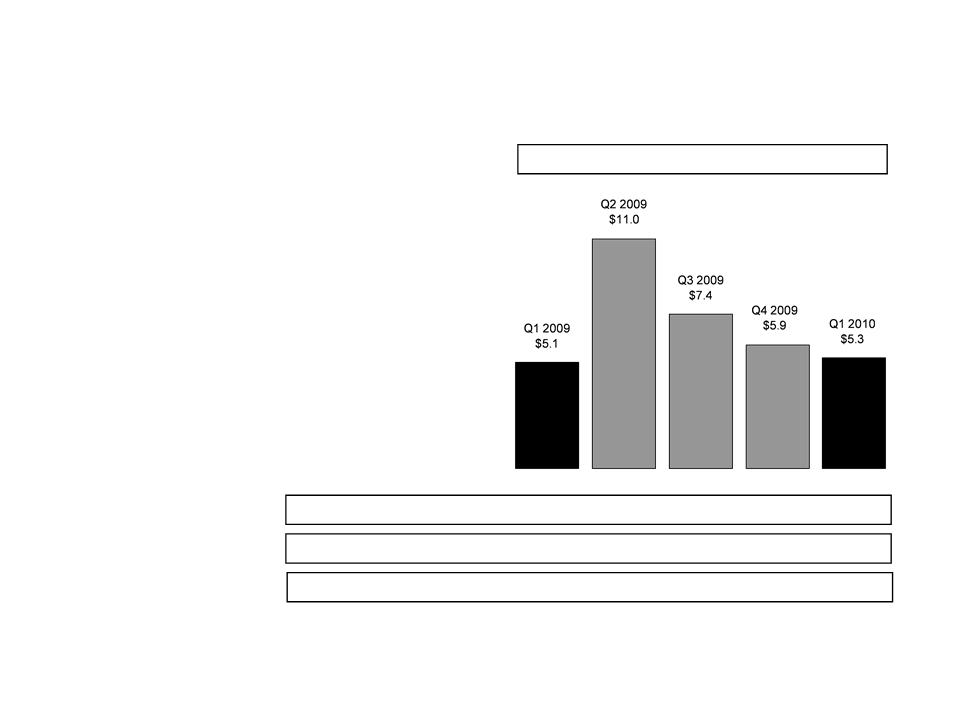
Segment
Performance
50
Colonial
Penn
*Operating earnings
exclude net realized gains (losses). See
Appendix for corresponding GAAP measure of
our consolidated results of operations.
our consolidated results of operations.
PTOI-Trailing 4
Quarters: $26.6 $29.3 $30.2 $29.4 $29.6
Revenues-Quarterly: $57.1 $62.7 $58.1 $57.8 $58.1
Pre-Tax
Operating Income*
Revenues -Tr. 4
Quarters: $229.4 $234.0 $235.1 $235.7 $236.7
($
millions)
§ Earnings
up 4%
• Primarily due to
favorable
mortality and growth in our block
of life insurance policies
mortality and growth in our block
of life insurance policies
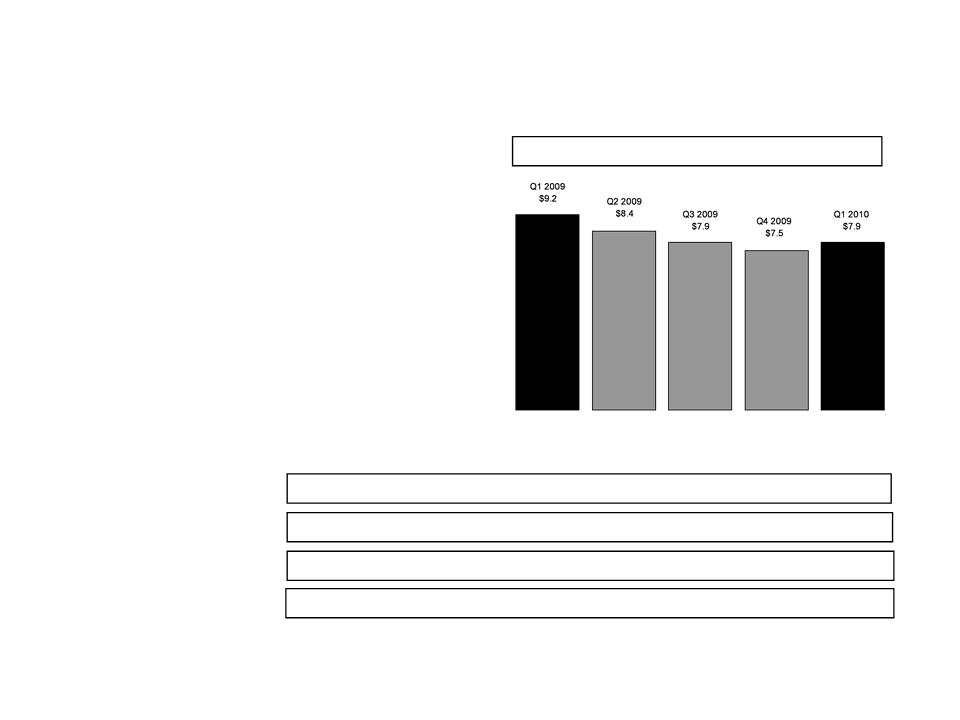
Premiums
-
Life
Insurance
51
Colonial
Penn
($
millions)
First-Year
Prems.-Tr. 4 Qtrs: $35.8 $35.3 $34.4 $33.0 $31.7
Total
Premiums-Quarterly: $47.0 $45.8 $45.6 $48.9 $47.3
Life -
First-Year Premiums
NAP-Quarterly: $12.3 $10.6 $10.6 $8.4 $13.1
NAP-Trailing 4
Quarters: $49.7 $45.8 $44.3 $41.9 $42.7
§ Sales
(NAP) up 7%
• Lead generation
momentum
building following 2009 capital
limitations
building following 2009 capital
limitations
• Increased lead
activity will drive
return to pre-2009 sales levels
return to pre-2009 sales levels
• NAP from lead-based
programs
up 32% over Q1 2009, and 76%
over Q4 2009
up 32% over Q1 2009, and 76%
over Q4 2009
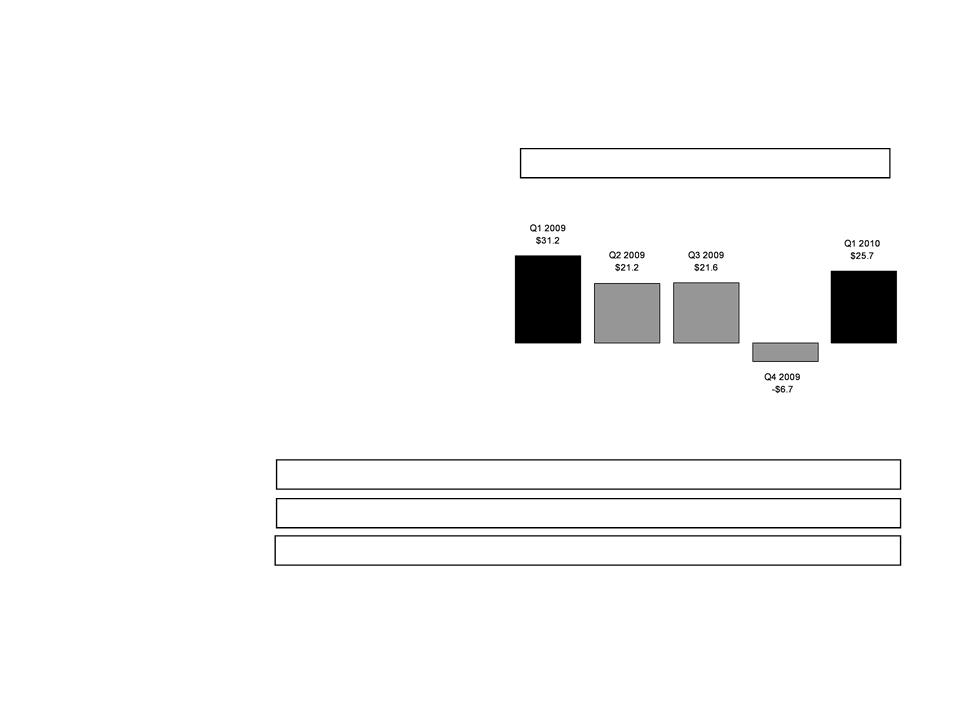
Segment
Performance
52
CIG
*Operating earnings
exclude net realized gains (losses). See Appendix for corresponding GAAP
measure
of our consolidated results of operations.
of our consolidated results of operations.
PTOI-Trailing 4
Quarters: $129.2 $118.1 $105.5 $67.3 $61.8
Revenues-Quarterly: $379.2 $382.5 $381.2 $357.7 $358.5
Pre-Tax
Operating Income (loss)*
Revenues-Tr. 4
Quarters: $1,511.7 $1,515.9 $1,525.3 $1,500.6 $1,479.9
($
millions)
§ Earnings
down 18%
• Lower Specified
Disease income
due primarily to reserve releases in
Q1 2009
due primarily to reserve releases in
Q1 2009
• Lower Life income
due primarily to
lost earnings on blocks reinsured in
2009
lost earnings on blocks reinsured in
2009
• Higher Annuity
income due to lower
surrenders on indexed annuities
surrenders on indexed annuities
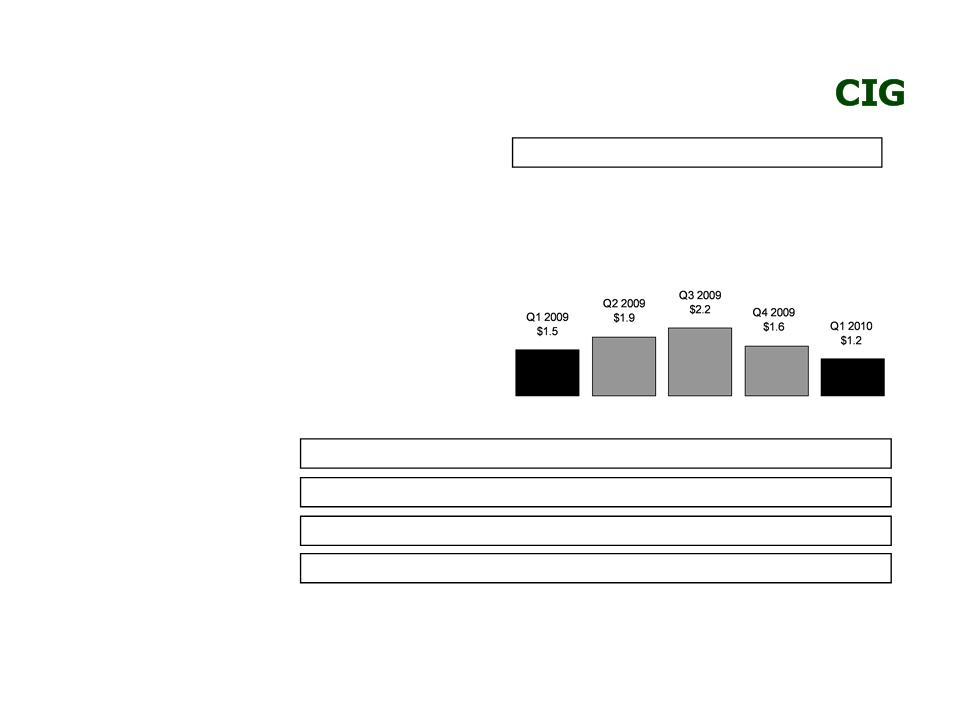
Premiums
-
Medicare
Supplement
53
($
millions)
First-Year
Prems.-Tr. 4 Qtrs: $8.3 $7.9 $8.0 $7.2 $6.9
Total
Premiums-Quarterly: $42.8 $44.4 $46.9 $43.7 $40.7
Medicare Supplement
- First-Year Premiums
NAP-Quarterly: $1.7 $1.3 $1.3 $1.5 $1.1
NAP-Trailing 4
Quarters: $8.3 $8.3 $7.8 $5.8 $5.2
§ First-year
collections down 20%
• Focus on core
products (i.e.,
Specified Disease)
Specified Disease)
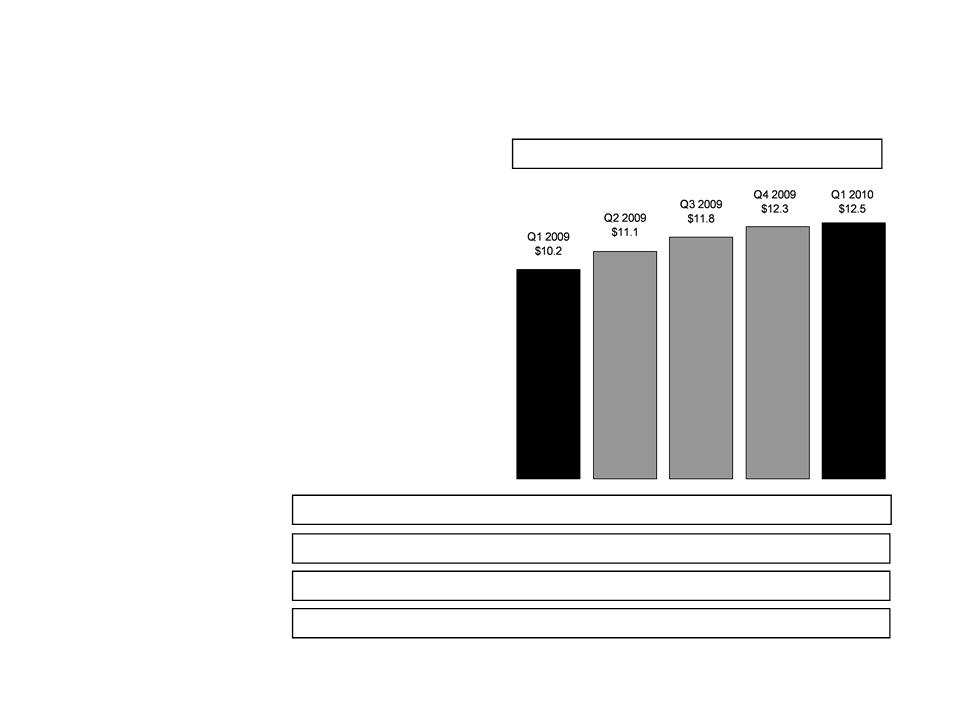
Premiums
-
Specified
Disease
54
CIG
($
millions)
First-Year
Prems.-Tr. 4 Qtrs: $40.2 $41.5 $43.6 $45.4 $47.7
Total
Premiums-Quarterly: $93.0 $95.1 $96.2 $99.0 $99.6
Specified Disease -
First-Year Premiums
NAP-Quarterly: $11.5 $14.7 $16.1 $15.2 $14.6
NAP-Trailing 4
Quarters: $48.7 $51.0 $54.3 $57.5 $60.6
§ NAP
up 28%
• Increased focus on
Specified
Disease products
Disease products
• Momentum increasing
in
Worksite market
Worksite market
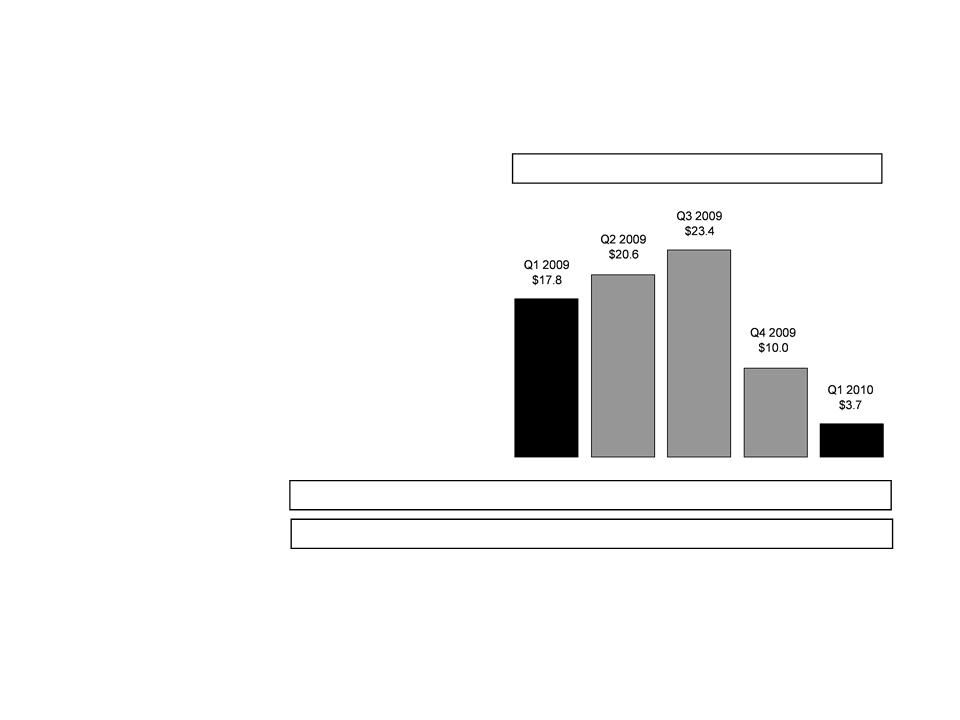
Premiums
-
Annuity
55
CIG
($
millions)
First-Year
Prems.-Tr. 4 Qtrs: $98.5 $84.7 $83.0 $71.8 $57.7
Total
Premiums-Quarterly: $19.5 $22.3 $25.2 $11.4 $5.1
Annuity
- First-Year Premiums
§ First-year
collections down 79%
• Increased focus on
core products
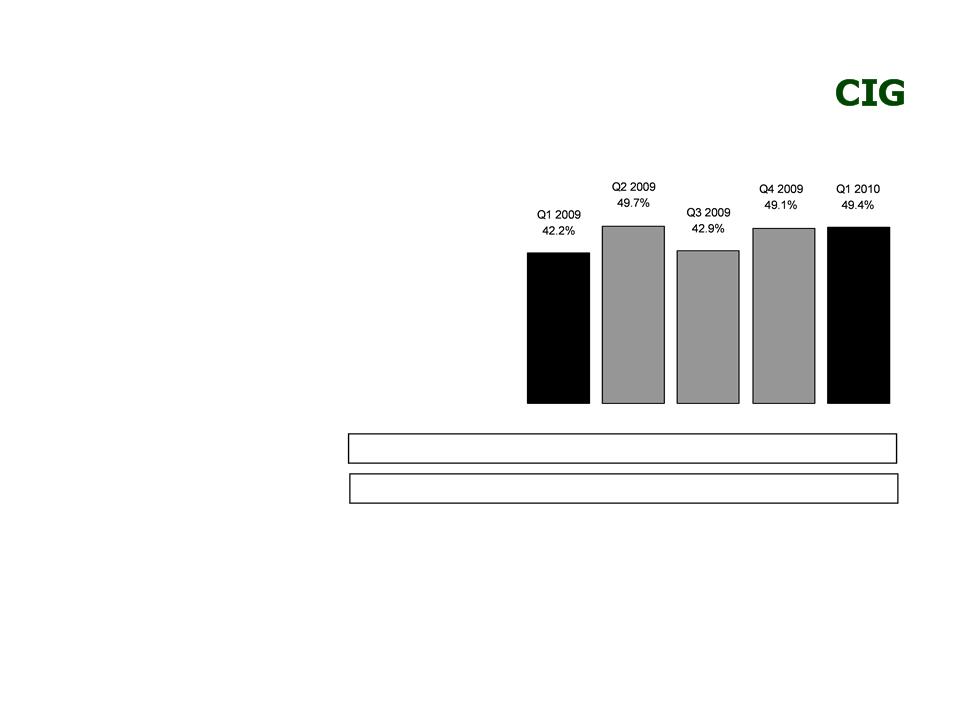
Interest-Adjusted
Benefit Ratio* -
Specified
Disease
56
Trailing 4 Quarter
Avg.: 41.8% 42.6% 41.2% 46.0% 47.8%
Qtrly.
non-int. adjusted: 76.0% 83.3% 76.6% 82.0% 82.3%
*We
calculate interest-adjusted benefit ratios by dividing insurance policy
benefits, less interest income on
the accumulated assets backing the insurance liabilities, by insurance policy income.
the accumulated assets backing the insurance liabilities, by insurance policy income.
§ Up
17% vs Q1 2009, which was
impacted by reserve releases
impacted by reserve releases

57
Information Related to Certain Non-GAAP Financial Measures
The
following provides additional information regarding certain non-GAAP measures
used in this presentation. A
non-GAAP measure is a
numerical measure of a company’s performance, financial position, or cash flows that excludes or includes amounts that are normally excluded
or included in the most directly comparable measure calculated and presented in accordance with GAAP. While management believes these
measures are useful to enhance understanding and comparability of our financial results, these non-GAAP measures should not be considered
as substitutes for the most directly comparable GAAP measures. Additional information concerning non-GAAP measures is included in our
periodic filings with the Securities and Exchange Commission that are available in the “Investor - SEC Filings” section of Conseco’s website,
www.conseco.com.
numerical measure of a company’s performance, financial position, or cash flows that excludes or includes amounts that are normally excluded
or included in the most directly comparable measure calculated and presented in accordance with GAAP. While management believes these
measures are useful to enhance understanding and comparability of our financial results, these non-GAAP measures should not be considered
as substitutes for the most directly comparable GAAP measures. Additional information concerning non-GAAP measures is included in our
periodic filings with the Securities and Exchange Commission that are available in the “Investor - SEC Filings” section of Conseco’s website,
www.conseco.com.
Operating
earnings measures
Management believes that an analysis of net income applicable to common stock before loss on extinguishment or modification of debt, net
realized gains or losses and increases to our valuation allowance for deferred tax assets (“net operating income,” a non-GAAP financial
measure) is important to evaluate the performance of the Company and is a key measure commonly used in the life insurance industry.
Management uses this measure to evaluate performance because loss on extinguishment or modification of debt, realized investment gains or
losses and increases to our valuation allowance for deferred tax assets are unrelated to the Company’s continuing operations.
Management believes that an analysis of net income applicable to common stock before loss on extinguishment or modification of debt, net
realized gains or losses and increases to our valuation allowance for deferred tax assets (“net operating income,” a non-GAAP financial
measure) is important to evaluate the performance of the Company and is a key measure commonly used in the life insurance industry.
Management uses this measure to evaluate performance because loss on extinguishment or modification of debt, realized investment gains or
losses and increases to our valuation allowance for deferred tax assets are unrelated to the Company’s continuing operations.
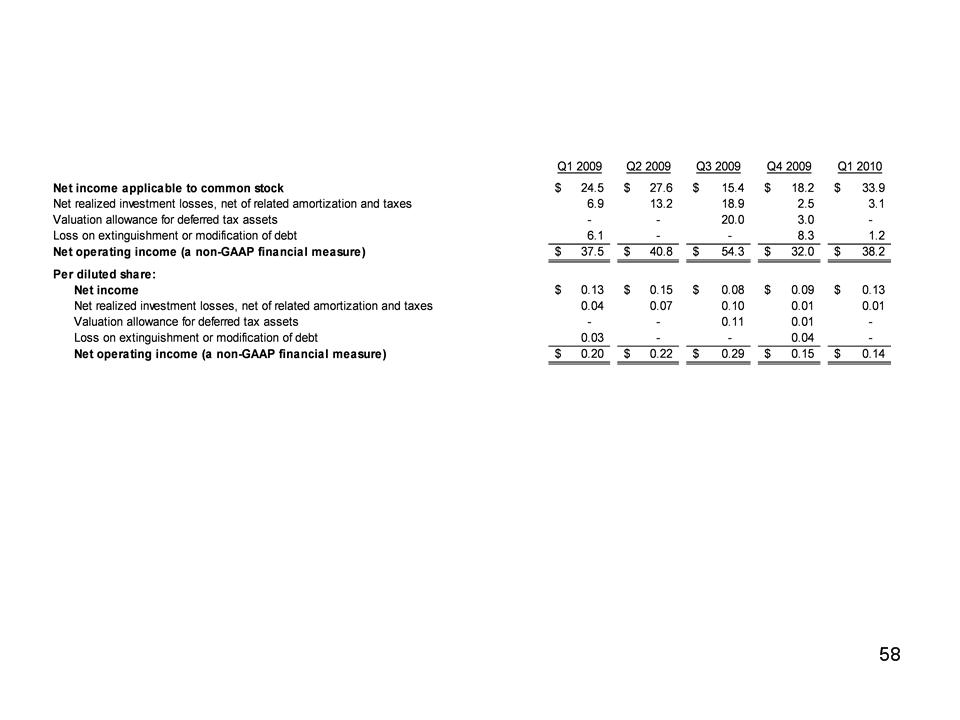
Information Related to Certain Non-GAAP Financial Measures
A
reconciliation of net income applicable to common stock to net operating income
(and related per-share amounts) is as follows (dollars in
millions, except per-share amounts):
millions, except per-share amounts):

Book
value, excluding accumulated other comprehensive income, per share
This non-GAAP financial measure differs from book value per share because accumulated other comprehensive income has been excluded
from the book value used to determine the measure. Management believes this non-GAAP financial measure is useful because it removes the
volatility that arises from changes in accumulated other comprehensive income. Such volatility is often caused by changes in the estimated fair
value of our investment portfolio resulting from changes in general market interest rates rather than the business decisions made by
management.
This non-GAAP financial measure differs from book value per share because accumulated other comprehensive income has been excluded
from the book value used to determine the measure. Management believes this non-GAAP financial measure is useful because it removes the
volatility that arises from changes in accumulated other comprehensive income. Such volatility is often caused by changes in the estimated fair
value of our investment portfolio resulting from changes in general market interest rates rather than the business decisions made by
management.
A
reconciliation from book value per share to book value per share, excluding
accumulated other comprehensive income (loss) is as follows
(dollars in millions, except per share amounts):
(dollars in millions, except per share amounts):
Information Related to Certain Non-GAAP Financial Measures

60
Operating
return measures
Management believes
that an analysis of return before loss on extinguishment or modification of
debt, net realized gains or losses, and
increases to our valuation allowance for deferred tax assets (“net operating income,” a non-GAAP financial measure) is important to evaluate the
performance of the Company and is a key measure commonly used in the life insurance industry. Management uses this measure to evaluate
performance because loss on extinguishment or modification of debt, realized investment gains or losses, and increases to our valuation
allowance for deferred tax assets are unrelated to the Company’s continued operations.
increases to our valuation allowance for deferred tax assets (“net operating income,” a non-GAAP financial measure) is important to evaluate the
performance of the Company and is a key measure commonly used in the life insurance industry. Management uses this measure to evaluate
performance because loss on extinguishment or modification of debt, realized investment gains or losses, and increases to our valuation
allowance for deferred tax assets are unrelated to the Company’s continued operations.
This
non-GAAP financial measure also differs from return on equity because
accumulated other comprehensive income (loss) has been
excluded from the value of equity used to determine this ratio. Management believes this non-GAAP financial measure is useful because it
removes the volatility that arises from changes in accumulated other comprehensive income (loss). Such volatility is often caused by changes in
the estimated fair value of our investment portfolio resulting from changes in general market interest rates rather than the business decisions
made by management.
excluded from the value of equity used to determine this ratio. Management believes this non-GAAP financial measure is useful because it
removes the volatility that arises from changes in accumulated other comprehensive income (loss). Such volatility is often caused by changes in
the estimated fair value of our investment portfolio resulting from changes in general market interest rates rather than the business decisions
made by management.
In
addition, our equity includes the value of significant net operating loss
carryforwards (included in income tax assets). In
accordance with
GAAP, these assets are not discounted, and accordingly will not provide a return to shareholders (until after it is realized as a reduction to taxes
that would otherwise be paid). Management believes that excluding this value from the equity component of this measure enhances the
understanding of the effect these non-discounted assets have on operating returns and the comparability of these measures from period-to-
period. Operating return measures are used in measuring the performance of our business units and are used as a basis for incentive
compensation.
GAAP, these assets are not discounted, and accordingly will not provide a return to shareholders (until after it is realized as a reduction to taxes
that would otherwise be paid). Management believes that excluding this value from the equity component of this measure enhances the
understanding of the effect these non-discounted assets have on operating returns and the comparability of these measures from period-to-
period. Operating return measures are used in measuring the performance of our business units and are used as a basis for incentive
compensation.
All
references to segment operating return measures assume a 25% debt to total
capital ratio at the segment level. Additionally,
corporate
expenses have been allocated to the segments.
expenses have been allocated to the segments.
Information Related to Certain Non-GAAP Financial Measures

A
reconciliation of return on common equity to operating return on common equity
(excluding accumulated other comprehensive income (loss) and
net operating loss carryforwards) is as follows (dollars in millions, except per share amounts):
net operating loss carryforwards) is as follows (dollars in millions, except per share amounts):
Information Related to Certain Non-GAAP Financial Measures
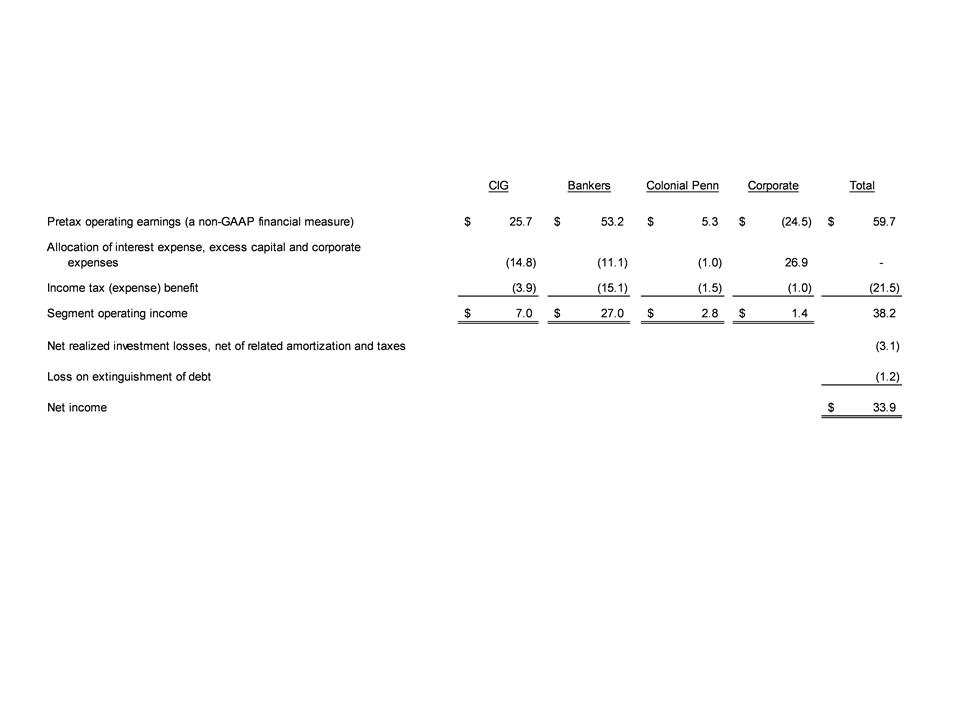
62
A
reconciliation of pretax operating earnings (a non-GAAP financial measure) to
segment operating income (loss) and consolidated net income
(loss) for the quarter ended March 31, 2010, is as follows (dollars in millions):
(loss) for the quarter ended March 31, 2010, is as follows (dollars in millions):
(Continued on next
page)
Information Related to Certain Non-GAAP Financial Measures
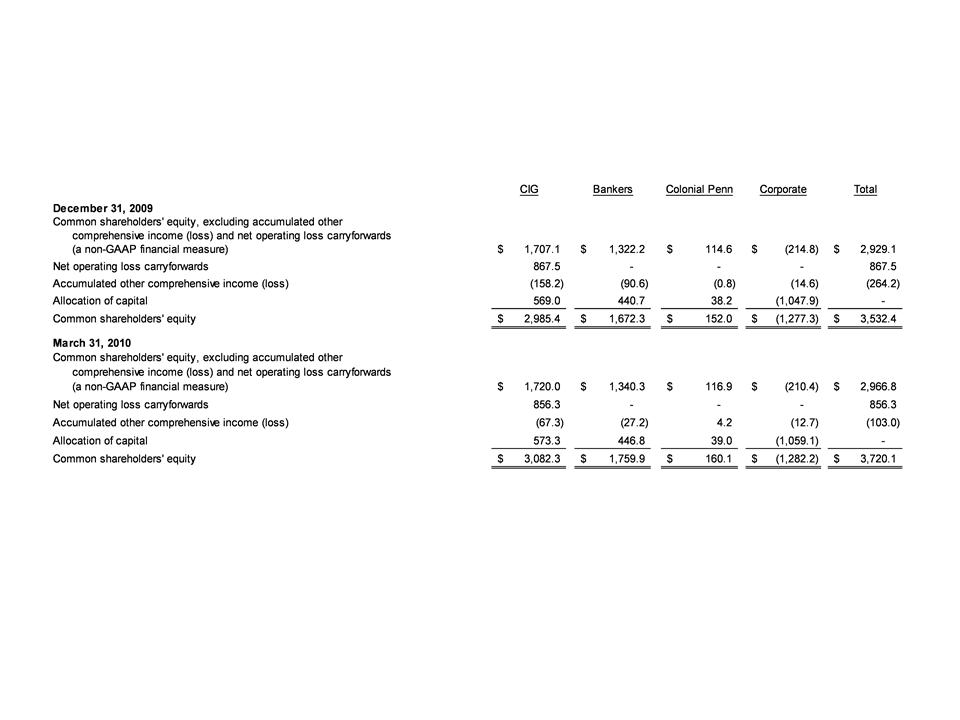
63
A
reconciliation of common shareholders’ equity, excluding accumulated other
comprehensive income (loss) and net operating loss
carryforwards (a non-GAAP financial measure) to common shareholders’ equity at March 31, 2010, is as follows (dollars in millions):
carryforwards (a non-GAAP financial measure) to common shareholders’ equity at March 31, 2010, is as follows (dollars in millions):
(Continued on next
page)
(Continued from
previous page)
Information Related to Certain Non-GAAP Financial Measures
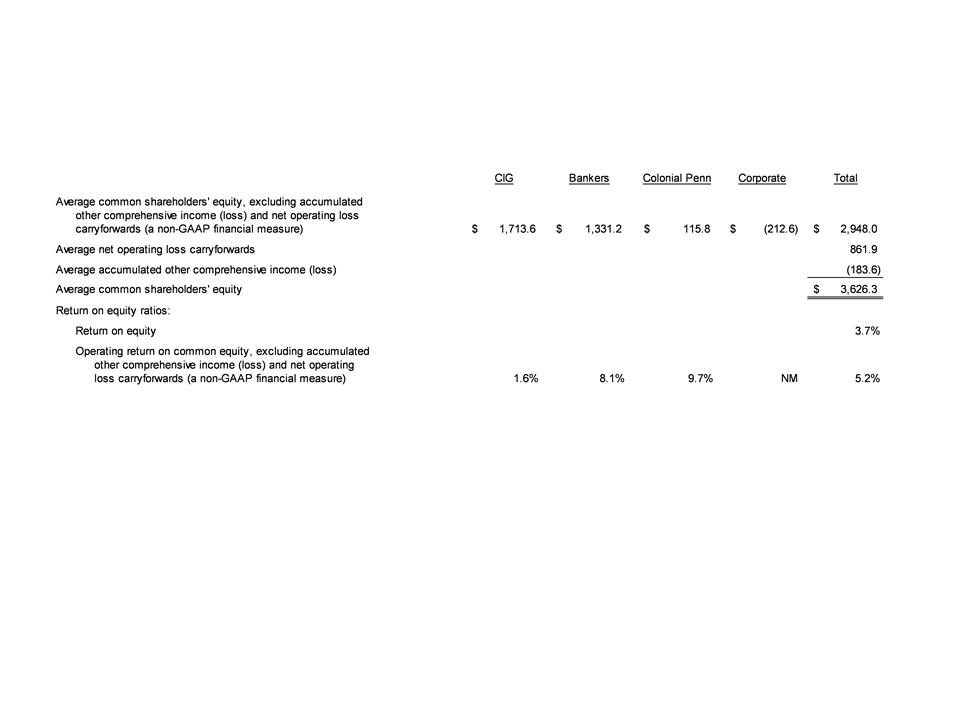
64
A
reconciliation of average common shareholders’ equity, excluding accumulated
other comprehensive income (loss) and net operating loss
carryforwards (a non-GAAP financial measure) to average common shareholders’ equity at March 31, 2010, is as follows (dollars in millions):
carryforwards (a non-GAAP financial measure) to average common shareholders’ equity at March 31, 2010, is as follows (dollars in millions):
(Continued from
previous page)
Information Related to Certain Non-GAAP Financial Measures

65
A
reconciliation of the debt to capital ratio to debt to capital, excluding
accumulated other comprehensive loss is as follows (dollars in
millions):
Debt
to capital ratio, excluding accumulated other comprehensive income
(loss)
This
non-GAAP financial measure differs from the debt to capital ratio because
accumulated other comprehensive income has been excluded
from the value of capital used to determine this measure. Management believes this non-GAAP financial measure is useful because it removes
the volatility that arises from changes in accumulated other comprehensive income. Such volatility is often caused by changes in the estimated
fair value of our investment portfolio resulting from changes in general market interest rates rather than the business decisions made by
management.
from the value of capital used to determine this measure. Management believes this non-GAAP financial measure is useful because it removes
the volatility that arises from changes in accumulated other comprehensive income. Such volatility is often caused by changes in the estimated
fair value of our investment portfolio resulting from changes in general market interest rates rather than the business decisions made by
management.
Information Related to Certain Non-GAAP Financial Measures
